The Jameel House of Traditional Arts in Cairo continues to impress with the outstanding work of its students, especially the 2024 graduating class. The programme, established in 2009 in collaboration with The King’s Foundation School of Traditional Arts, Community Jameel and the Egyptian Ministry of Culture, offers intensive training in traditional arts and crafts.
This year introduced traditional joinery, known as gamiya, as a new specialisation alongside existing woodwork techniques like inlay, carving and wood turning. Students also explored brasswork techniques for the first time.
Inspired by Islamic art from Cairo, Iran and Central Asia, the class of 2024 produced intricate mangour screens, mother-of-pearl and bone-inlaid furniture and carved wooden pieces. Their works form a stunning collection of furniture and home accessories.
Students in ceramics, metalwork and gypsum carving also contributed remarkable pieces, creating a harmonious collection that showcases the richness of Egyptian craft.
Mamdouh Sakr
Programme Manager
The Jameel House of Traditional Arts in Cairo
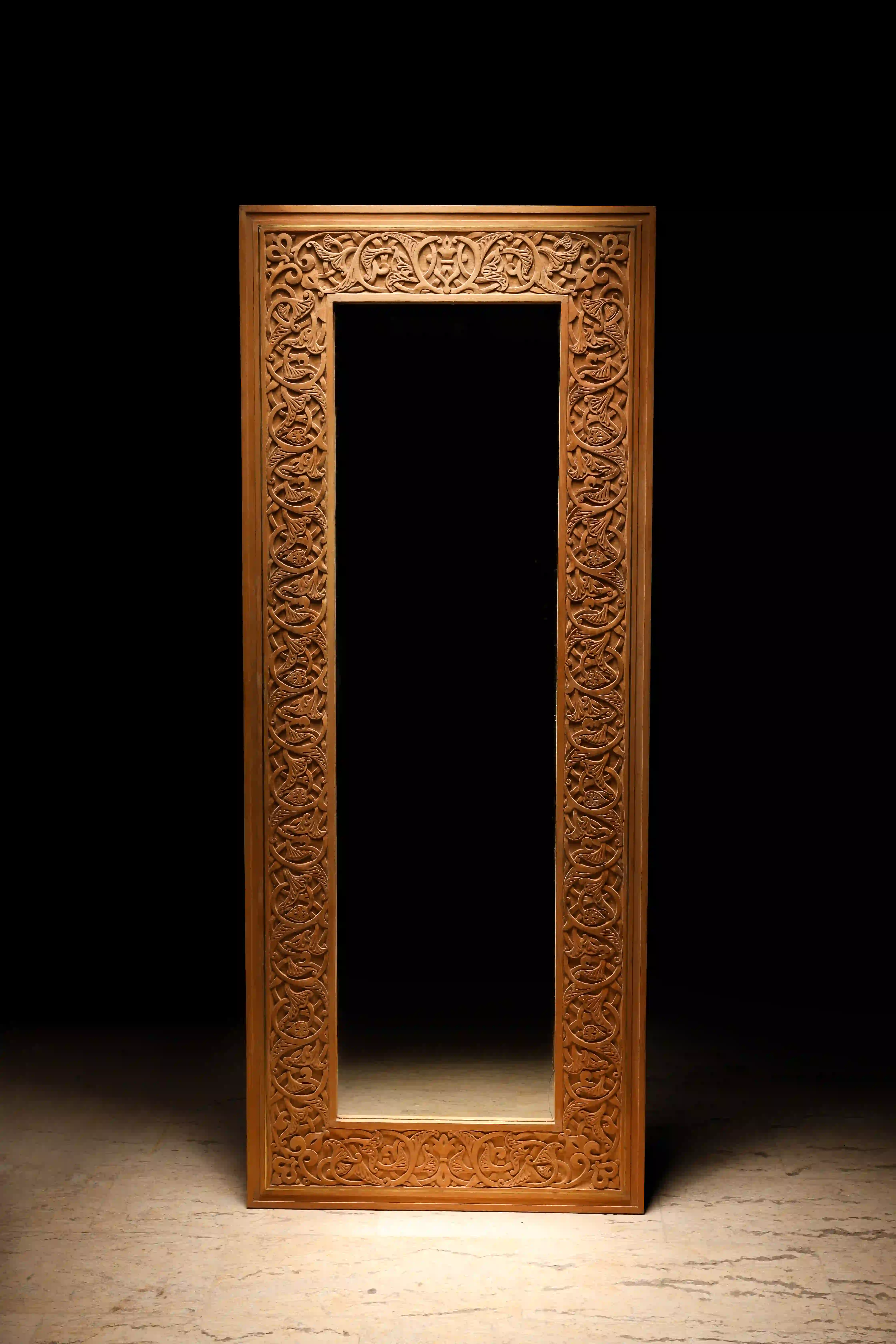
Mirror frame
176 x 71 cm
This mirror frame serves as a tangible representation of growth and transformation. It is a piece that can be proudly displayed, not just for its functional beauty, but for the profound meaning it carries—a reminder of achievements made and the endless possibilities that lie ahead in the graduate’s future endeavours.
The mirror itself, nestled within the warm embrace of the wooden frame, offers a clear reflection that invites you to gaze into its depths. It is not just a functional piece but a work of art that enhances any room it graces.
Whether hung in a cosy living room, a serene bedroom or a rustic hallway, it becomes a focal point, drawing admiration and sparking conversations about its origins and the talent behind its creation.
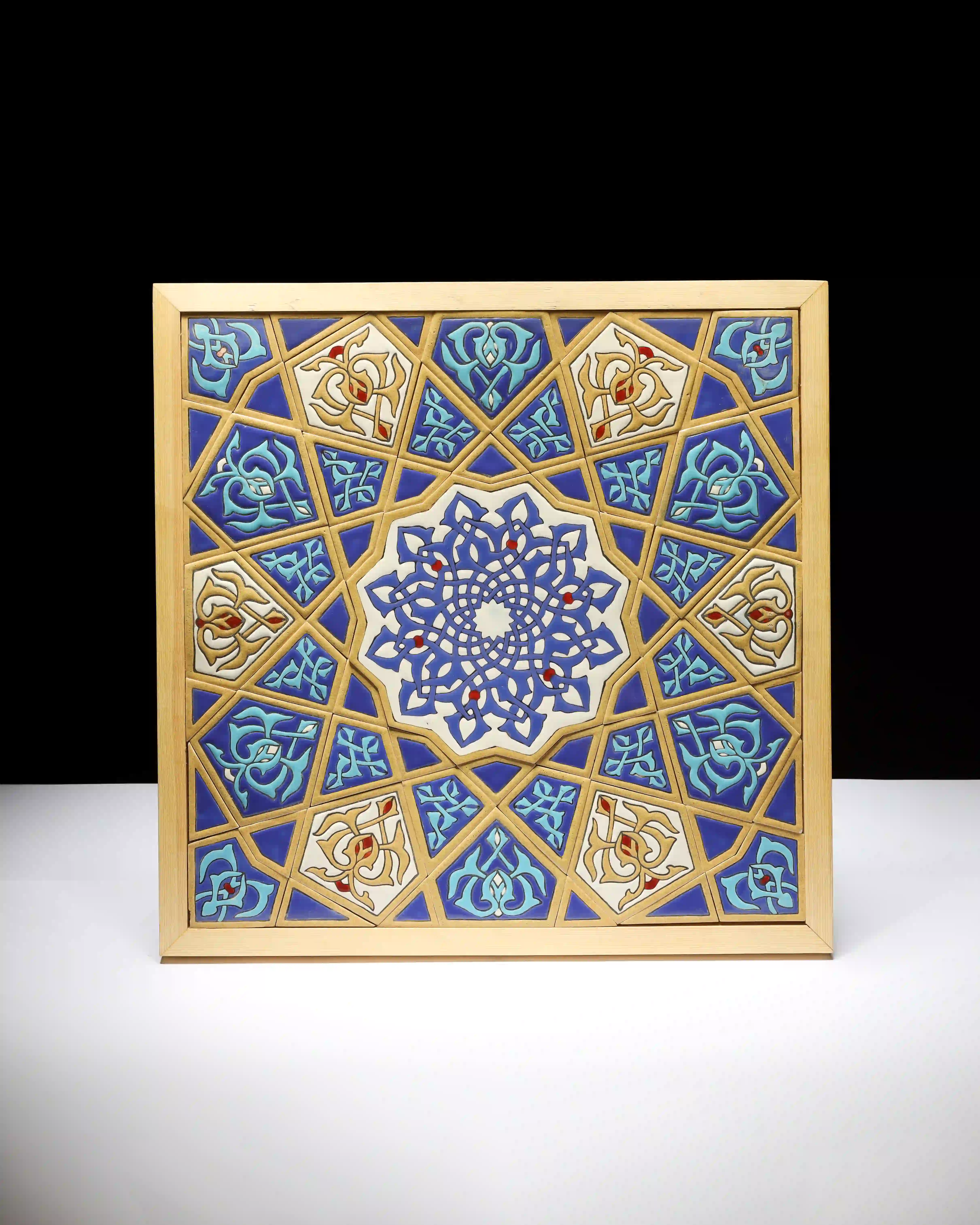
Cuerda seca blue and turquoise ceramic wall panel
55 x 55 cm
A panel inspired by the Qur’an of Sultan Baybars Al-Jashankir, one of the most important Qur’ans of the Mamluk era.
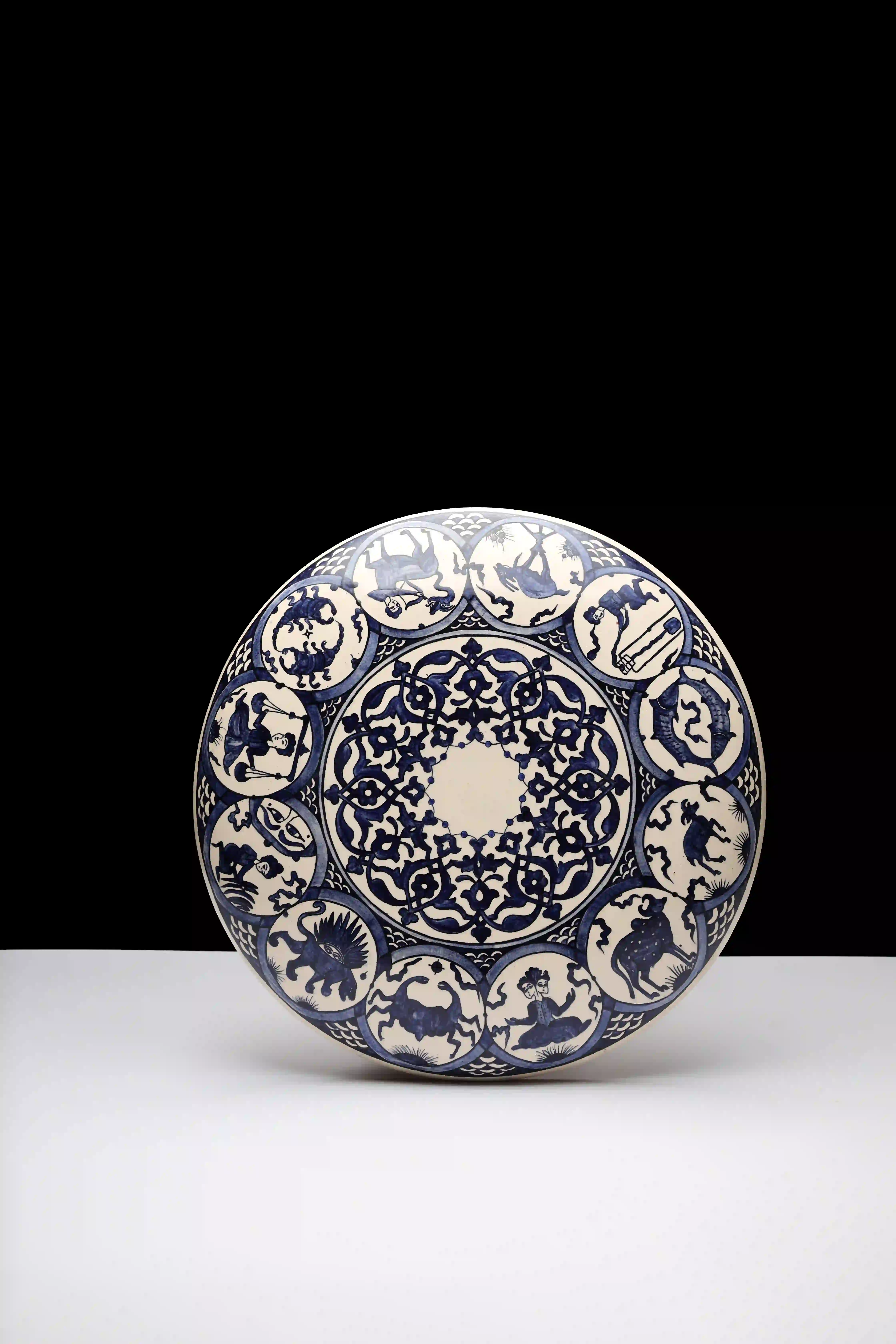
Painted ceramic plate
37 cm
The work is inspired by a painted plate representing the twelve zodiac signs made in 16th-century Iran.
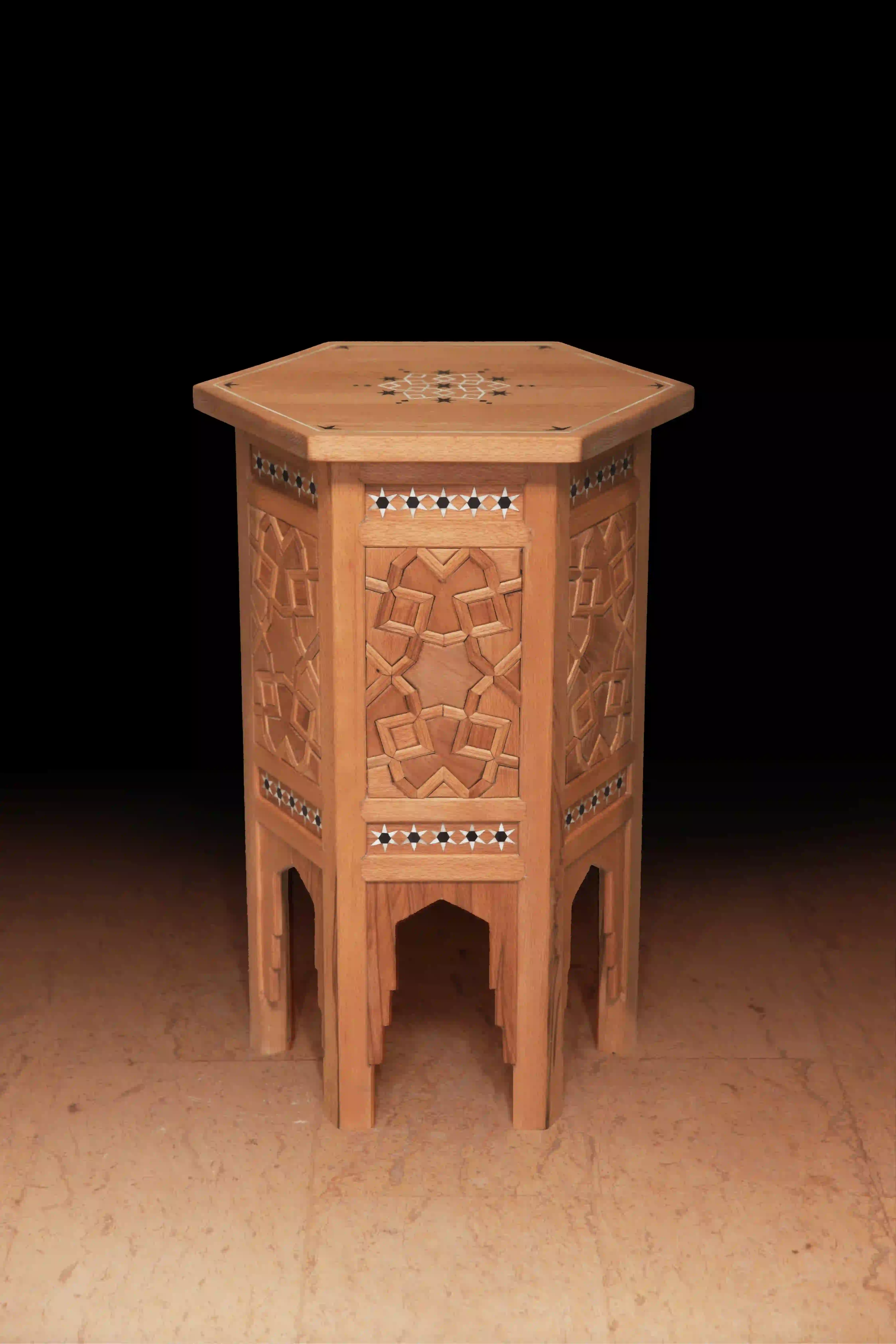
Wooden side table in traditional Mamluk style
64 x 45 cm
The beechwood side table is hexagonal in shape, inspired by a Mamluk-style dining chair and the Minbar of Al-Ghouri Mosque in Cairo.
At the top and bottom of the table, there are small inlaid pieces of bone and ebony in the form of hexagonal stars. The tabletop is also composed of inlaid bone and ebony in the same geometric pattern as the side elements.
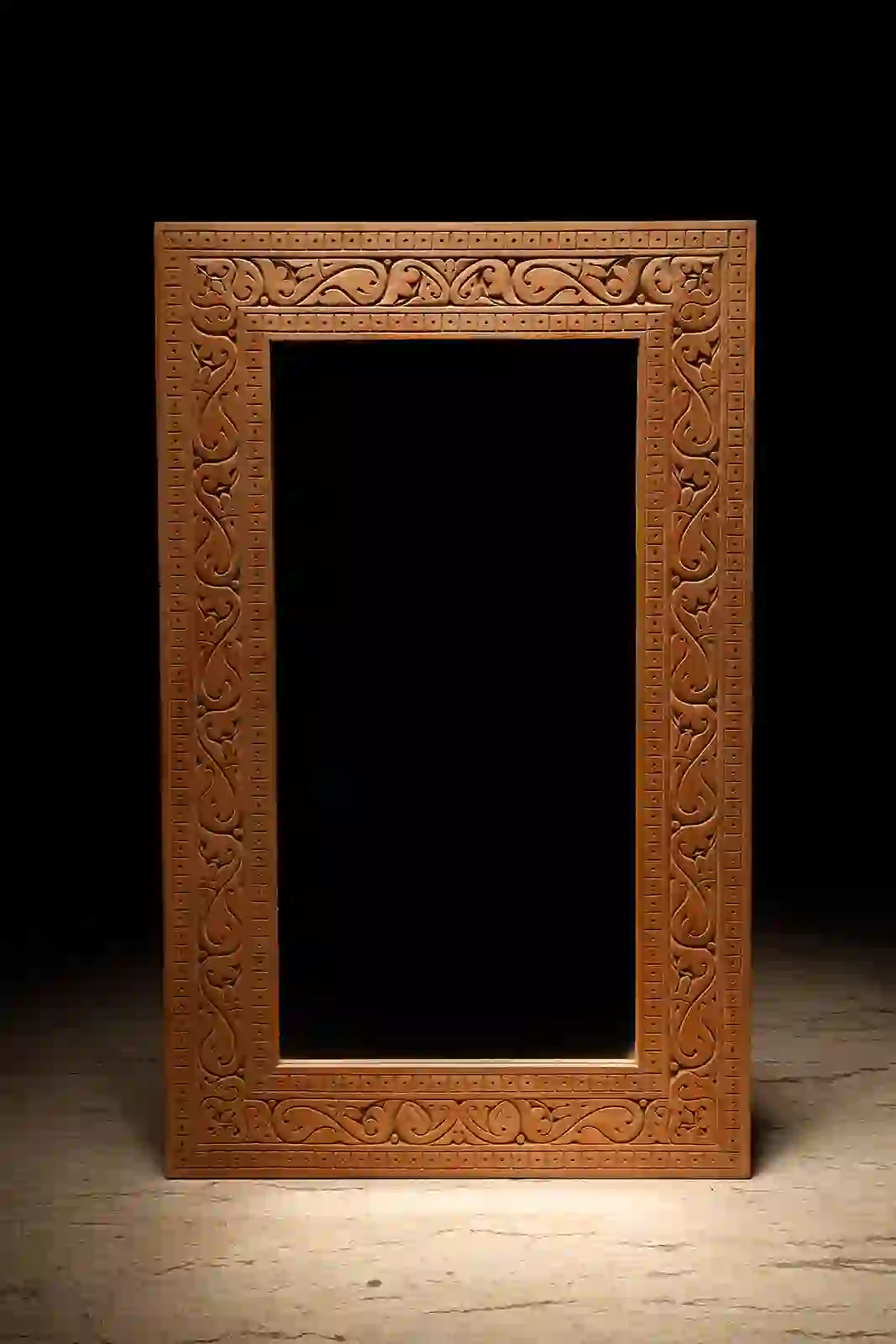
Ibn Tulun mirror frame
108 x 66 x 13 cm
The design of the mirror frame was inspired by the soffits of the multiple arches that surround the large courtyard in the Ahmad ibn Tulun Mosque, which are decorated with a wide variety of patterns.
At the top and bottom of the table, there are small inlaid pieces of bone and ebony in the form of hexagonal stars. The tabletop is also composed of inlaid bone and ebony in the same geometric pattern as the side elements.
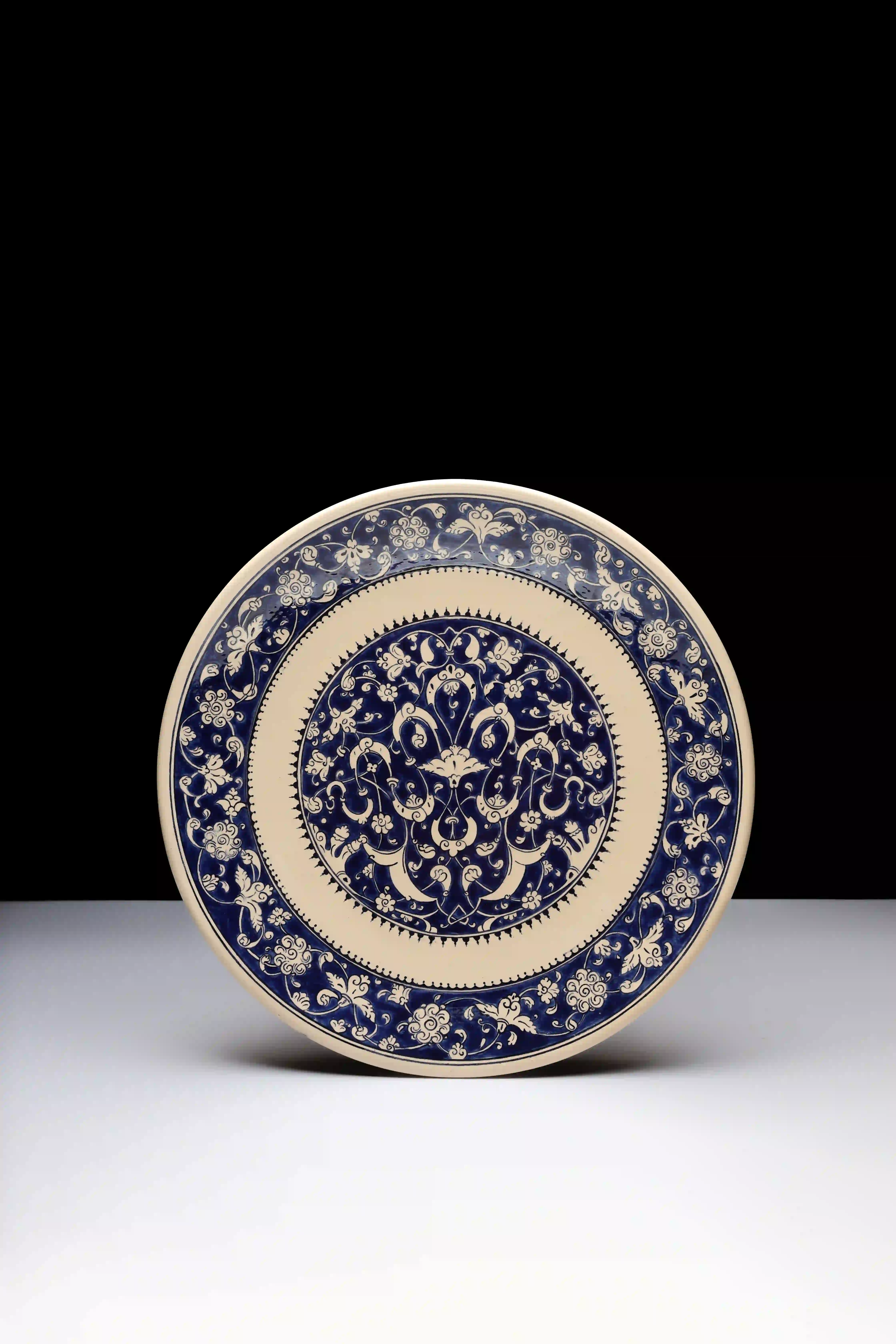
Iznik earthenware plate
35 cm
The slender, looped motifs at the centre of the decoration on this Iznik earthenware plate are derived from depictions of clouds in Chinese art. These features are typical of ceramics made in Iznik in the early 16th century.
The design was based on the highly stylised plant forms, knots and other patterns favoured by the Ottoman court.
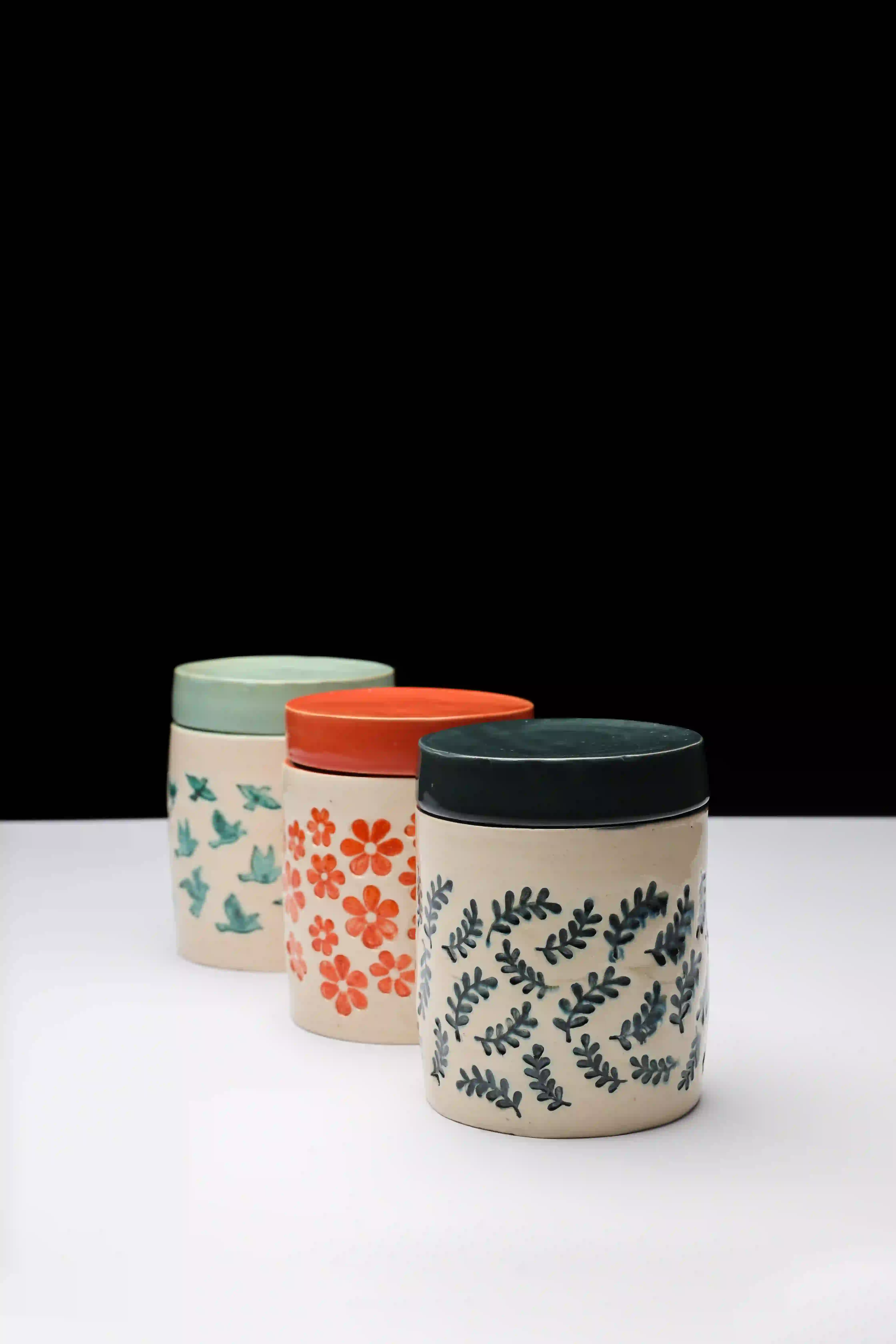
Tea set
10 cm
A tea set inspired by nature using the stamp technique.
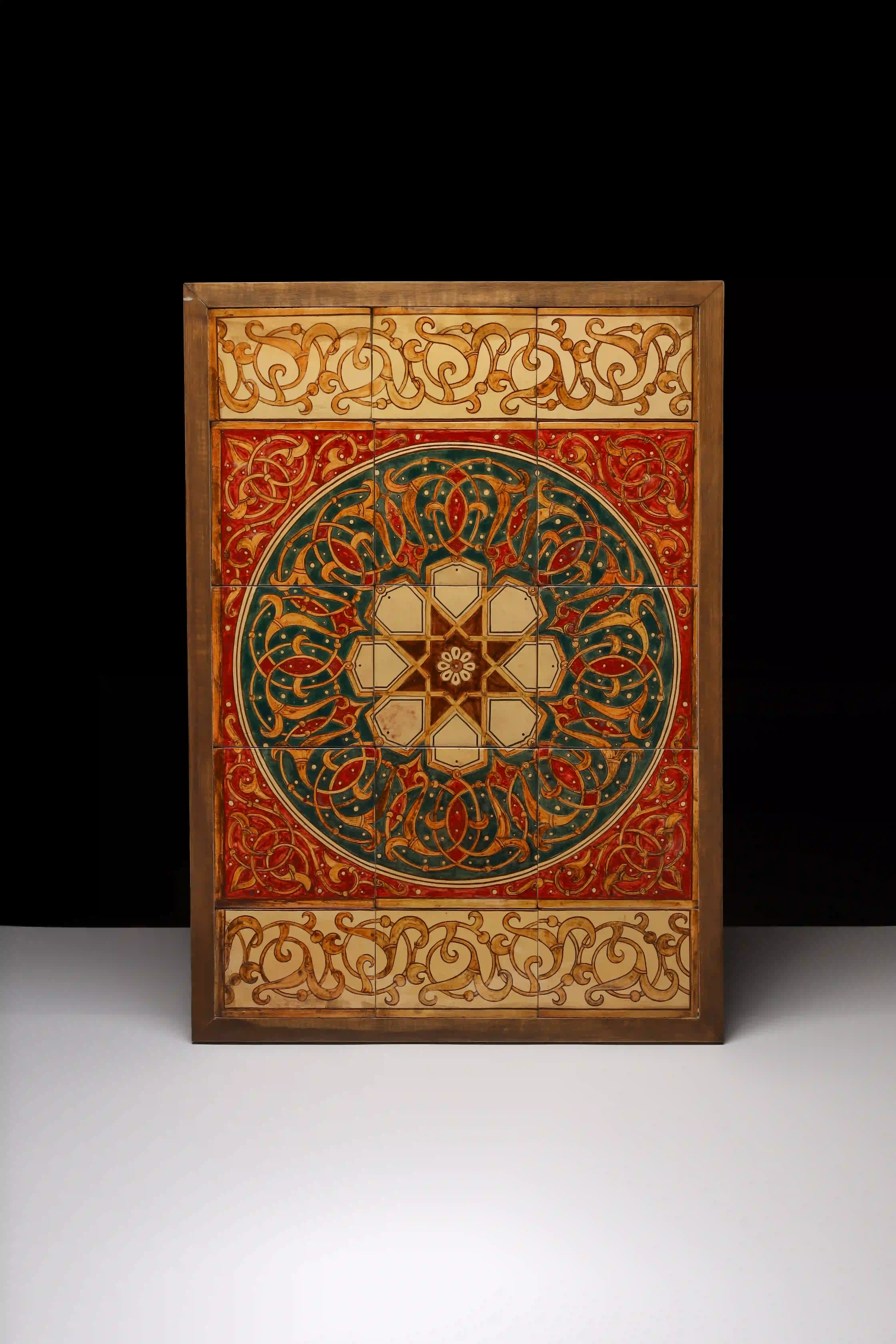
Ancient manuscript ceramic tile panel
60 x 45 cm
This ceramic tile panel takes inspiration from a cherished Moroccan Qur’an frontispiece from the Saadi dynasty era (16th – 17th century). The design features a lush, symmetrical arrangement of stylised foliage, with curling, flat, rounded and pointed leaves springing from a central stem. At the centre, the overlapping leaves coalesce into an elegant eight-pointed star motif, creating a geometric focal point amidst the organic forms. The vibrant oxide pigments and dyes result in a rich, harmonious palette that brings the botanical elements to life, capturing the masterful craftsmanship and artistic sensibilities of the Saadi period.
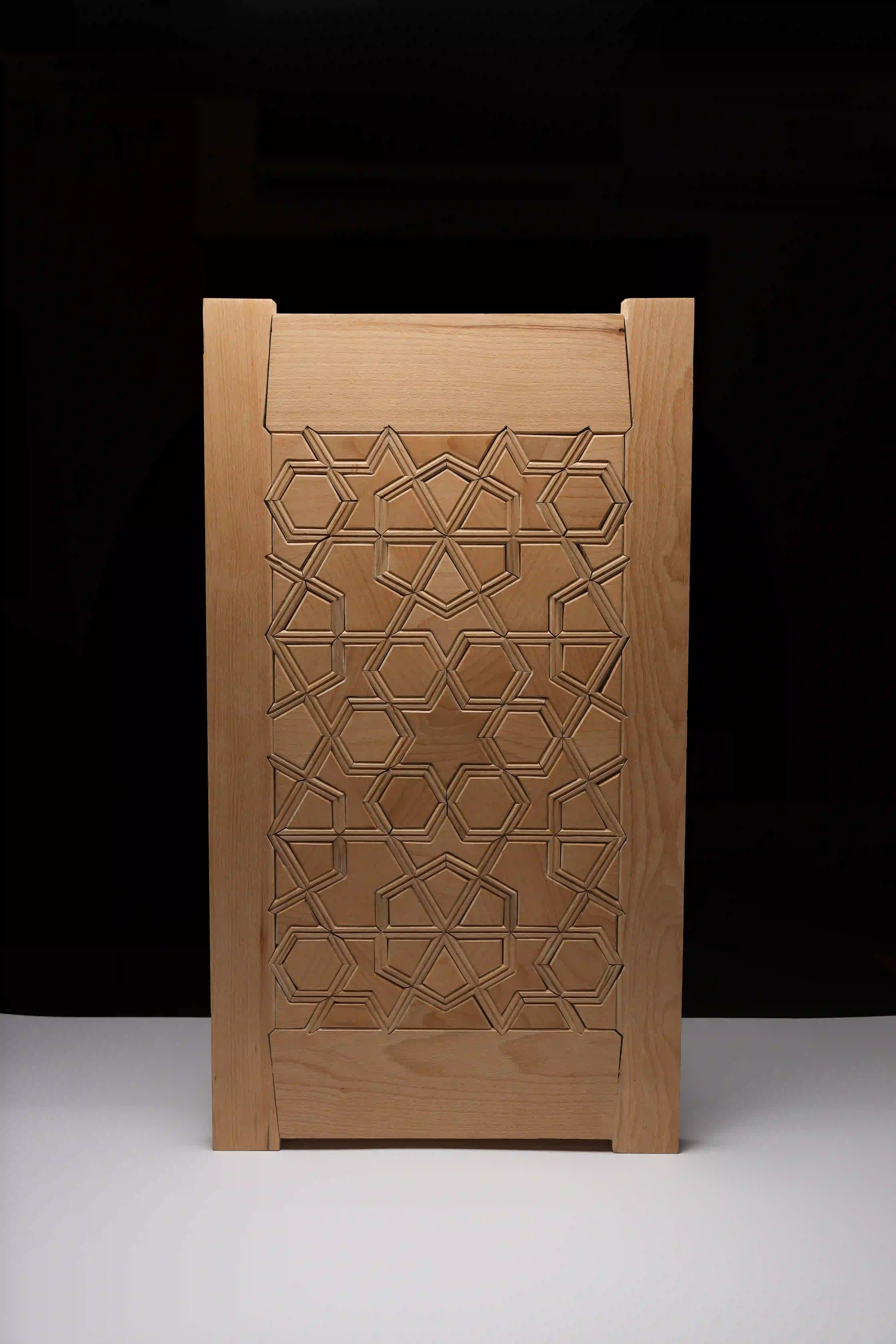
Hexagonal kündekari panel
44.5 x 77.2 cm
This kündekari panel with hexagonal pattern is made of 183 pieces. It is an exquisite example of intricate woodcraft, showcasing mastery and precision of this traditional art.
Each piece of the panel is meticulously cut and fitted together without the use of nails or adhesives, demonstrating the high level of skill and craftsmanship involved.
The interlocking design not only ensures durability but also reflects the rich cultural heritage and artistic traditions from which kündekari originated.
Used as a decorative wall piece element, this panel stands as a testament to the timeless beauty and complexity of traditional woodworking techniques.
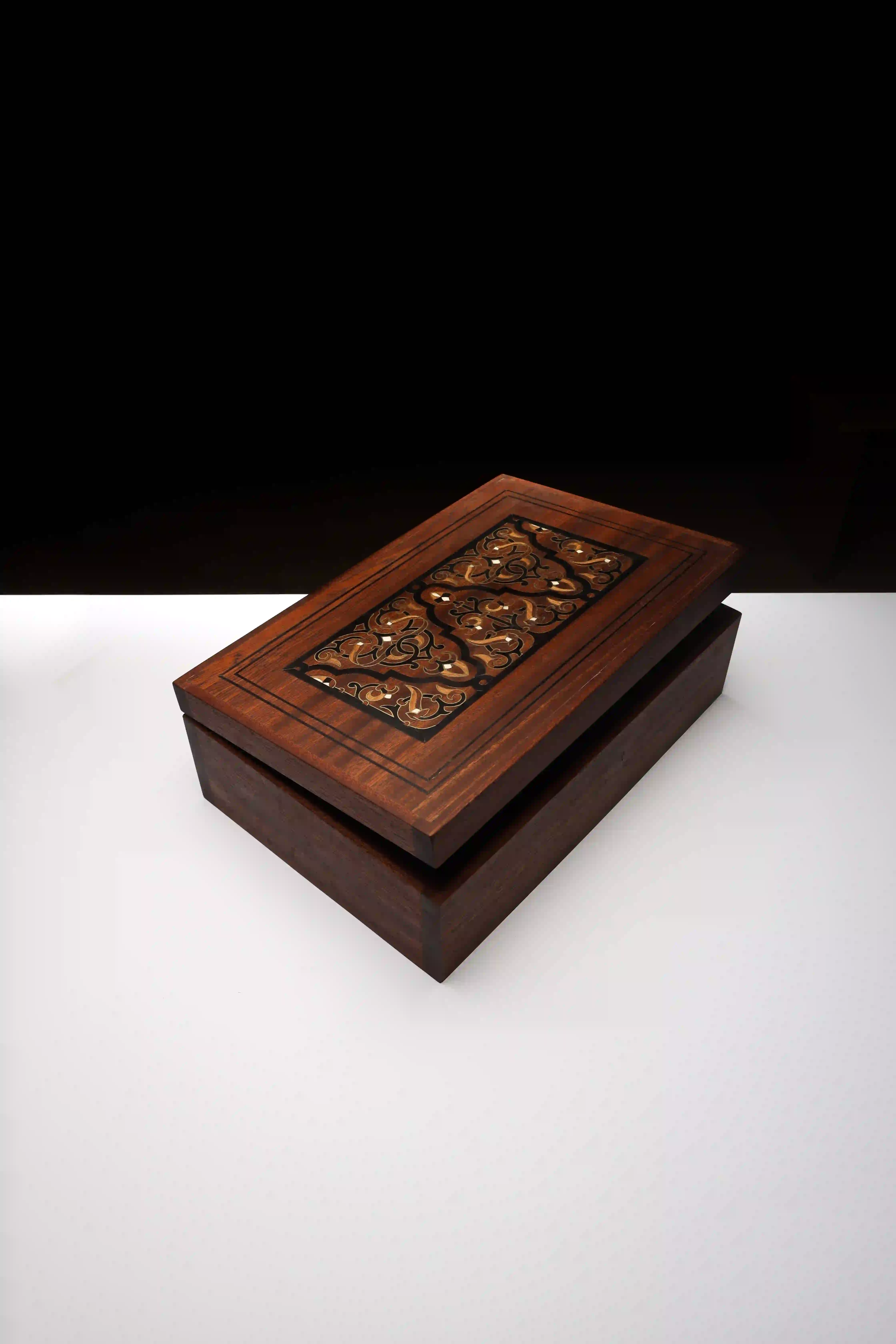
Koutoubia shakmagiya box
40 x 26.6 x 13.3 cm
The decorations of this box are inspired by the pulpit of the Koutoubia Mosque in Marrakesh, considered one of the most remarkable works ever created by Islamic artisans. The construction began around AD 1137 in Córdoba, the centre of Andalusian arts and literature, under the orders of the last Almoravid sultan, Ali Ibn Yusuf. After its completion around 1143, the pulpit was shipped in pieces from Córdoba and reassembled in Marrakesh. The pulpit’s decorative scheme— featuring intricately carved wooden panels, bone-inlaid floral motifs and a combination of various types of reddish-brown and dark brown (African blackwood) wood—covers its surface in a brilliant and stunning manner. This inspired the artist to use a variety of materials and harmonious colours to design this special jewellery box.
Wood inlay was one of the many techniques mastered by the carpenters of Al-Andalus, where small pieces of different materials were assembled to create specific patterns, particularly on wooden boxes and cabinets. This mahogany box is inlaid with various types of wood, including ebony and beech, in addition to bone and yellow copper wire, to create floral decorations inspired by those found on the staircase of the Koutoubia Mosque pulpit.
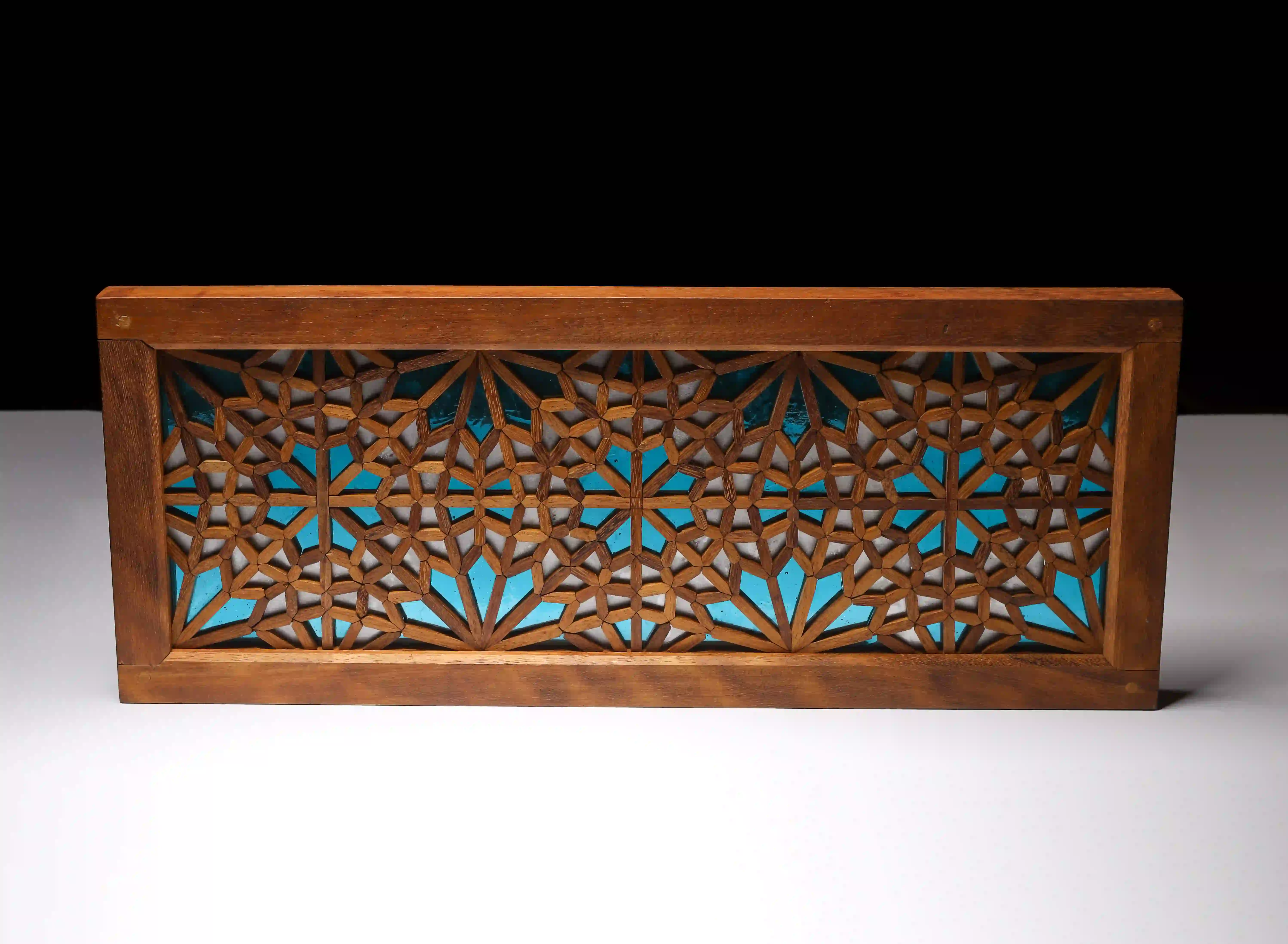
Jali glass window
30.5 x 75.5 cm
Inspired by a decorative door in Cairo’s Gayer-Anderson Museum, three different joinery techniques were used to create this window: the kumiko technique, inspired by Japanese crafts; the Abu Janzirtechnique, inspired by the Khanaqah of Faraj ibn Barquq Mosque; and the Iranian kündekari technique, which uses coloured glass as fillings.
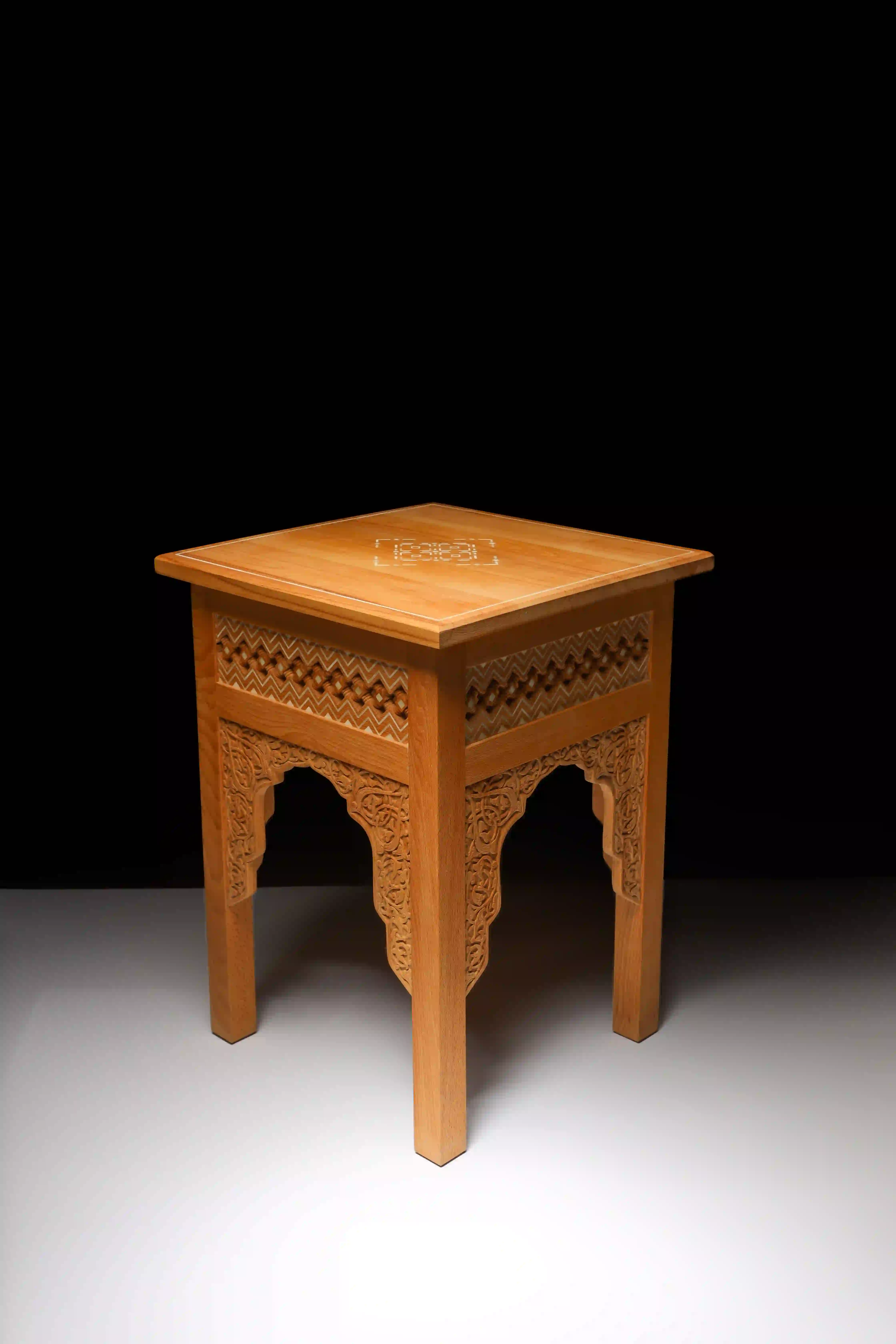
Camel bone inlaid turnings and carved beechwood side table
43 x 43 x 60 cm
A side table inspired by the Minbar of Saladin in Al-Aqsa Mosque in Jerusalem. The intricacy of the inlay work and carving are remarkable.
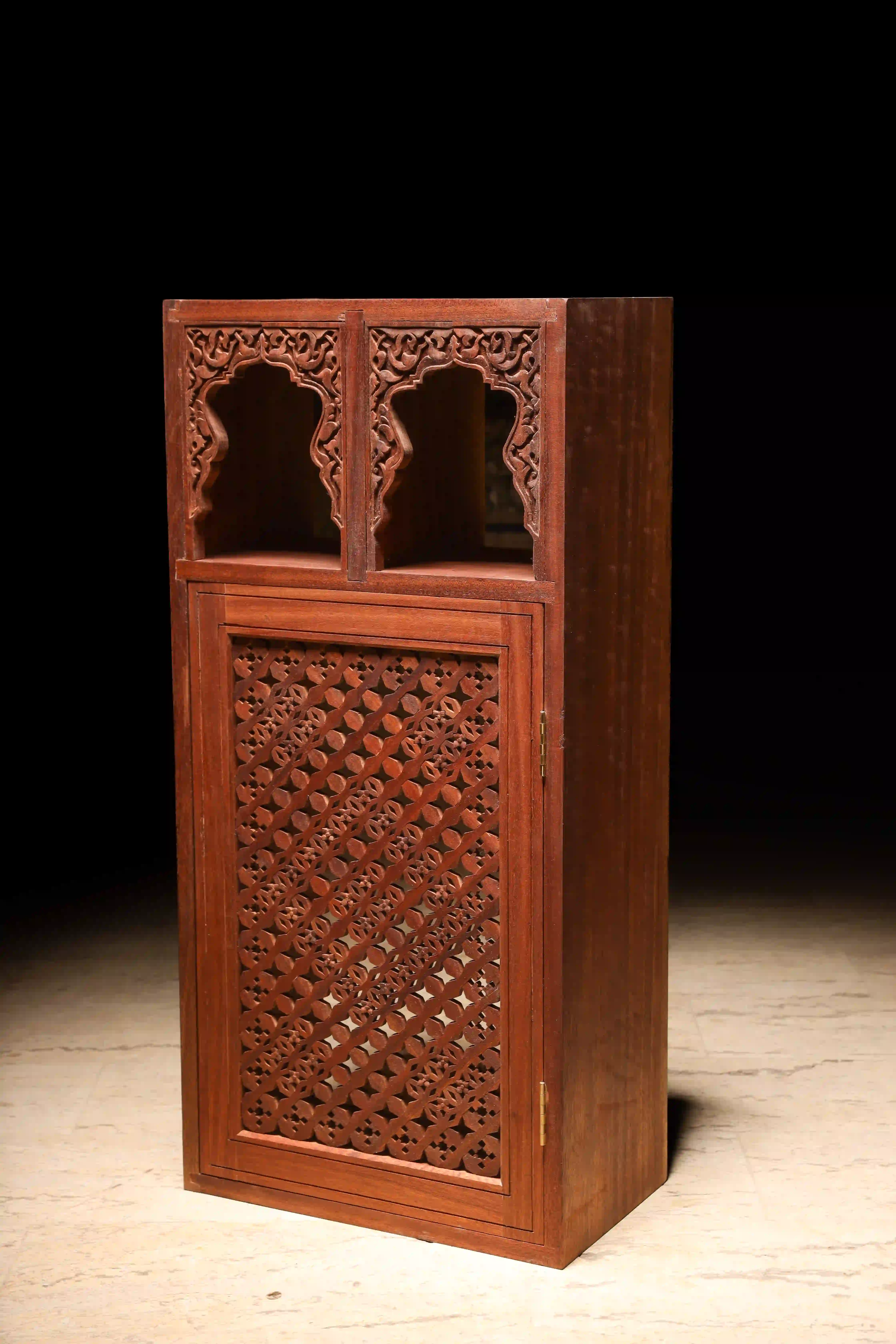
Bunchberry-mangour cabinet
92 x 46 x 26 cm
This wall cabinet combines traditional mangour craftwork and decorations of tiny arquette flowers, similar to bunchberry flowers, fitted within the mangour negative space without using nails, screws or glue.
The two carved arches bearing floral ornaments are made of mahogany wood.
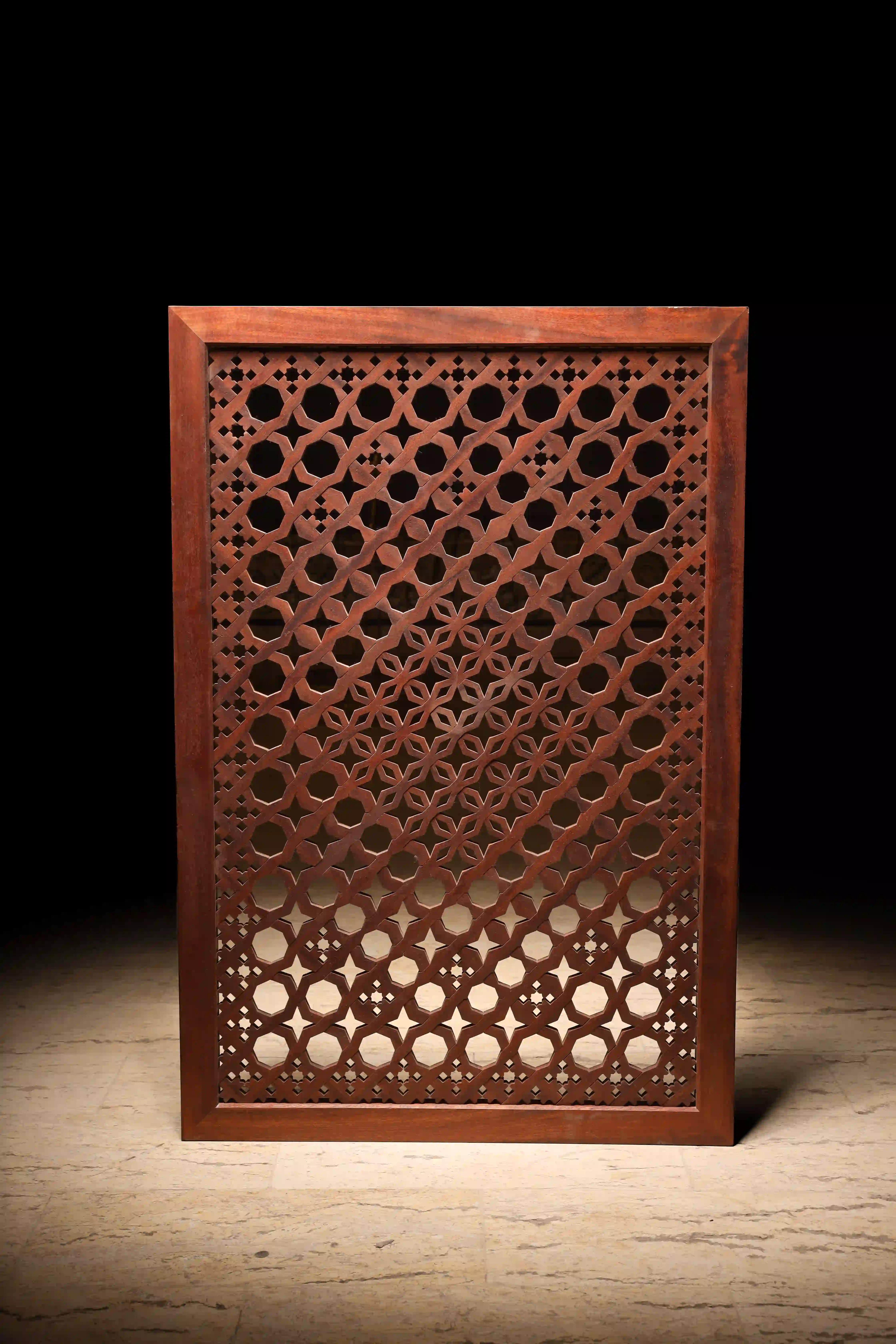
Mangour wood partition design
140 x 72 x 3 cm
Mangour is an architectural element made of wooden latticework, a square grid that expands and contracts in specific ways to express four- and eight-fold symmetry in the negative space.
The mangour interlocking system holds the pieces together without the use of nails or glue. When formed, it creates a net-like veil between physical spaces. Its main function in architecture is to ensure air and light circulation, while maintaining privacy. The elements of mangour can easily be taken apart, transported and re-assembled.
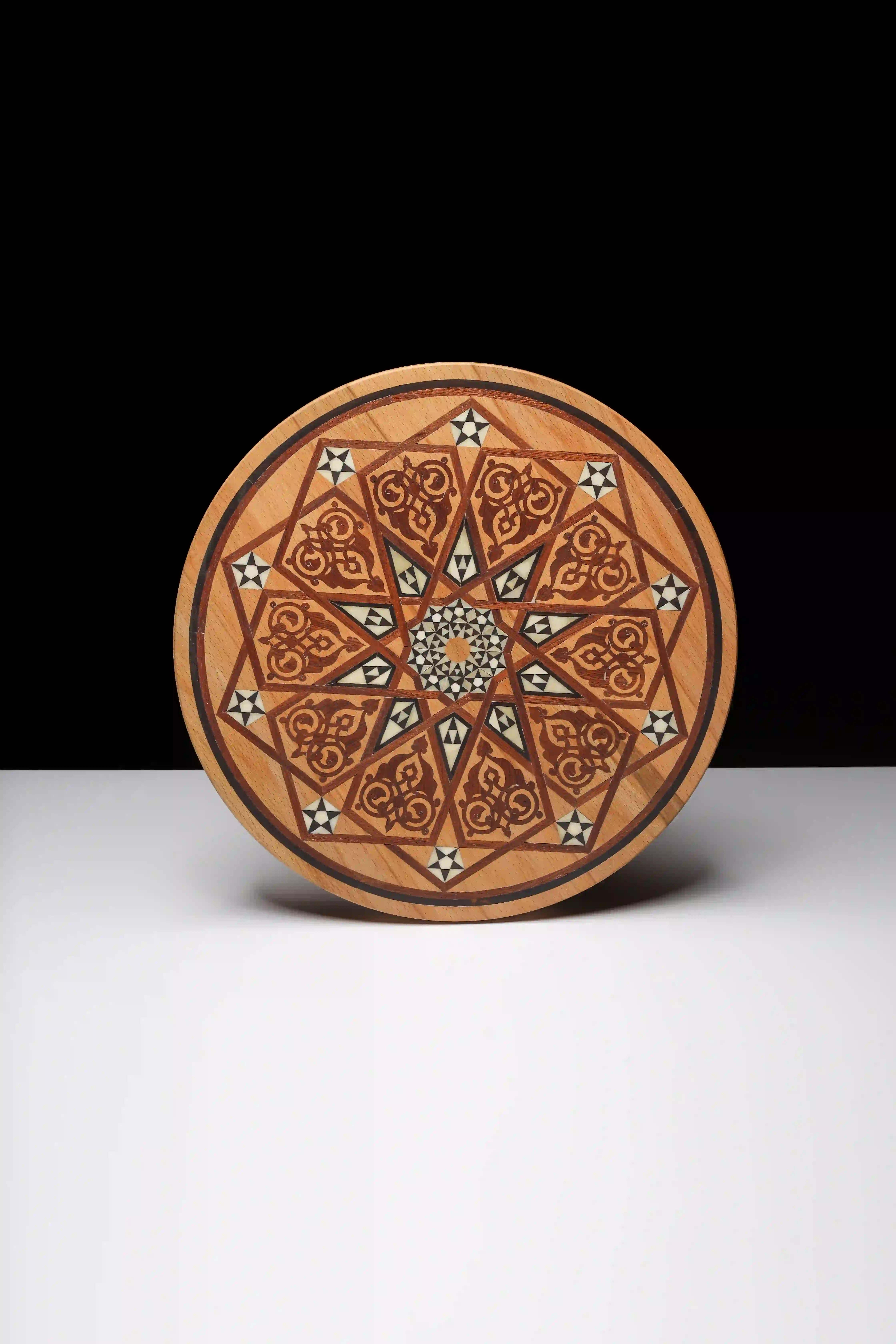
Panel inspired by the Minbar of Saladin
42 cm
The project is a panel inspired by one of the units found on Saladin’s pulpit (minbar) in Al-Aqsa Mosque in Jerusalem. The geometric network of the panel consists of a decagonal pattern. The project was executed using the inlay technique on a beechwood surface and uses mahogany, ebony and bone.
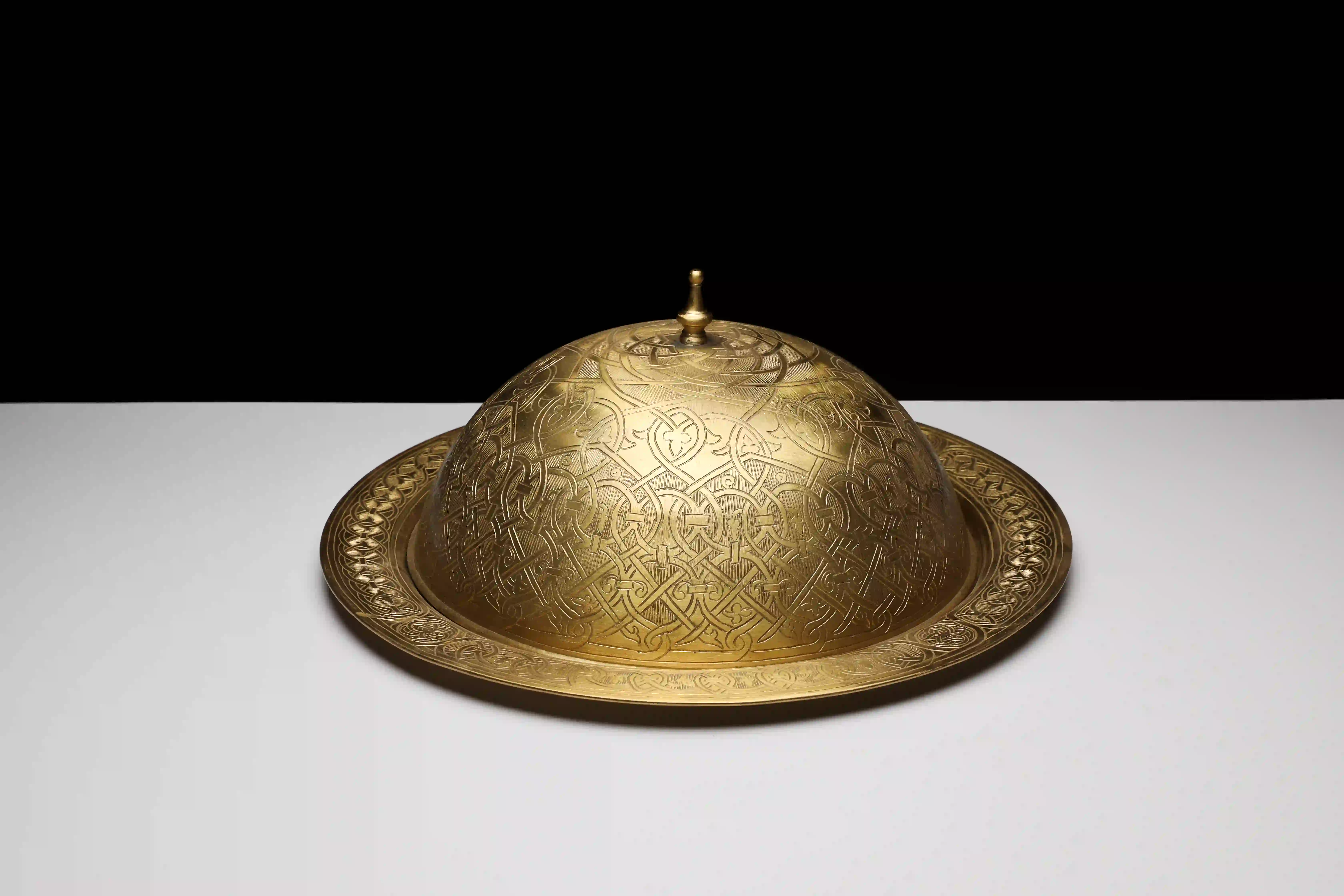
Engraved brass serving tray with dome shaped lid
11 x 30 x 38 cm
This brass tray’s pattern was inspired by a brass bowl inlaid with silver, originating from 15th-century Mamluk-era Damascus, which is located in the Metropolitan Museum of Art, New York.
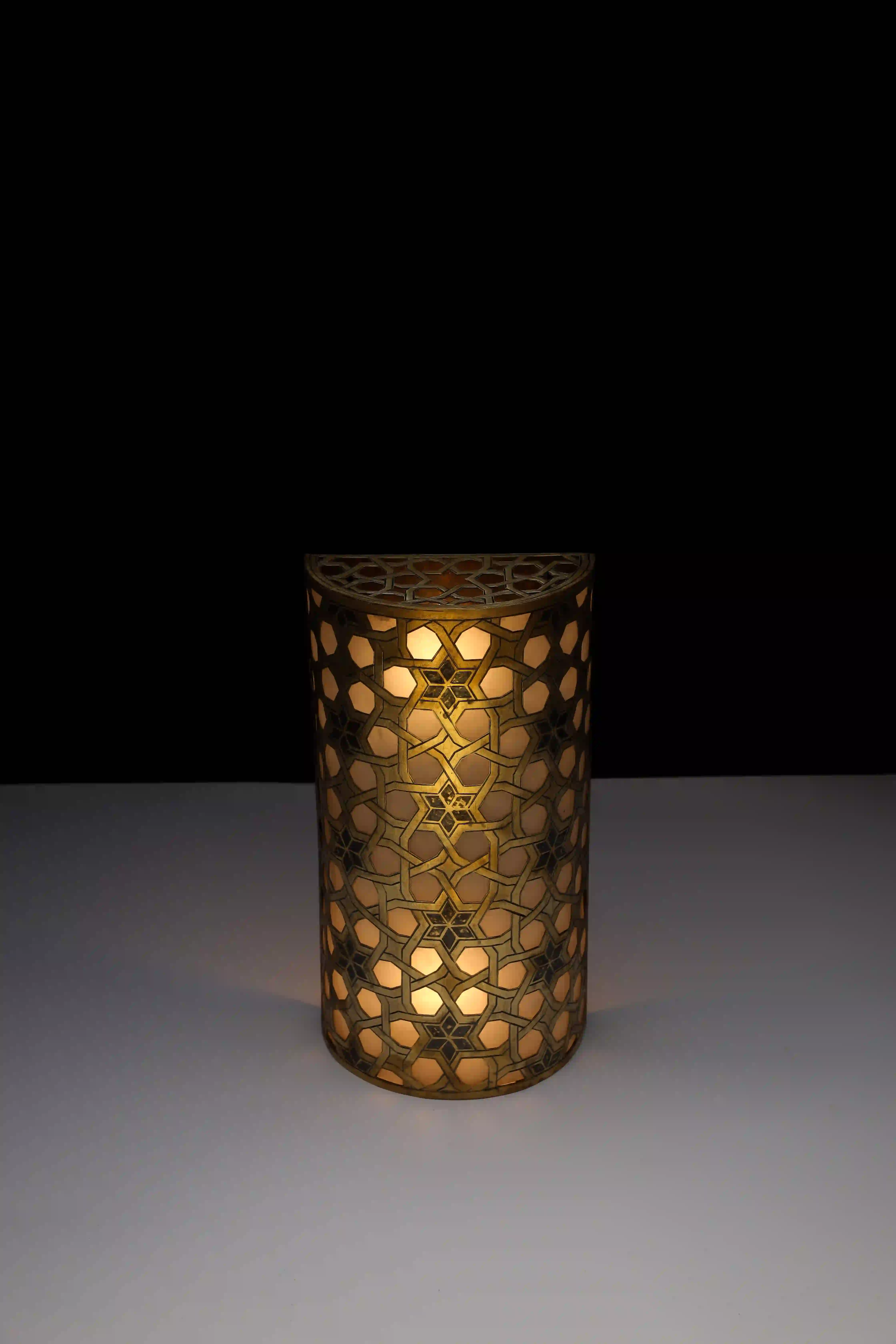
Al-Maridani wall appliqué
30 x 15 cm
This brass wall appliqué is crafted with engraved and intricately cut brass. The piece radiates a warm glow, while casting a reflection influenced by the architecture of themihrab (niche indicating the direction of prayer) in Al-Maridani Mosque in Al-Darb Al-Ahmar in Cairo.
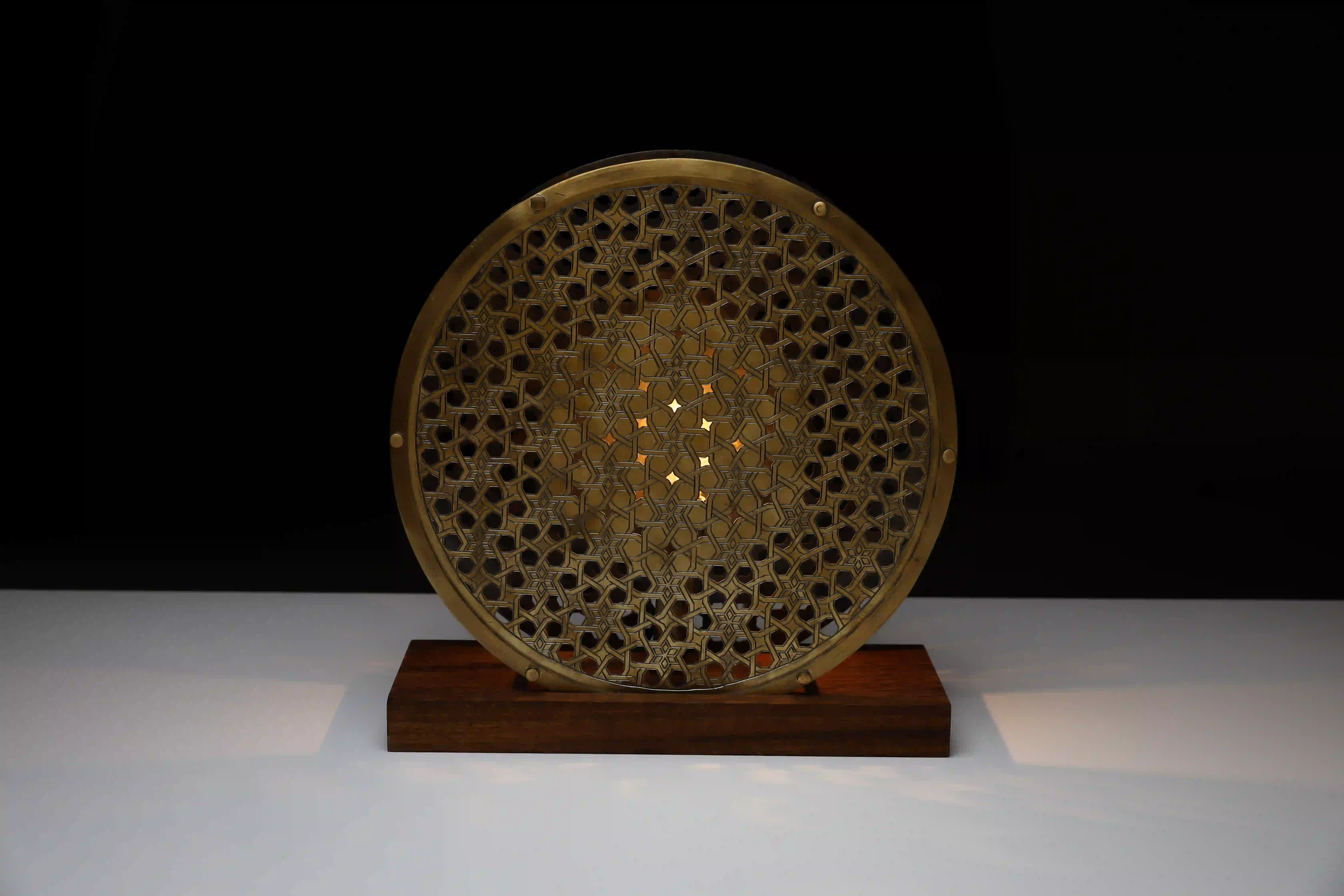
Al-Maridani wall appliqué
31 x 30 cm
This brass table lamp is inspired by the beautiful mihrab of Al-Maridani Mosque in Al-Darb Al-Ahmar. The brass is engraved and cut to reflect this elegant Islamic geometric pattern. It blends traditional charm with a modern touch, casting a warm glow through its intricate design.
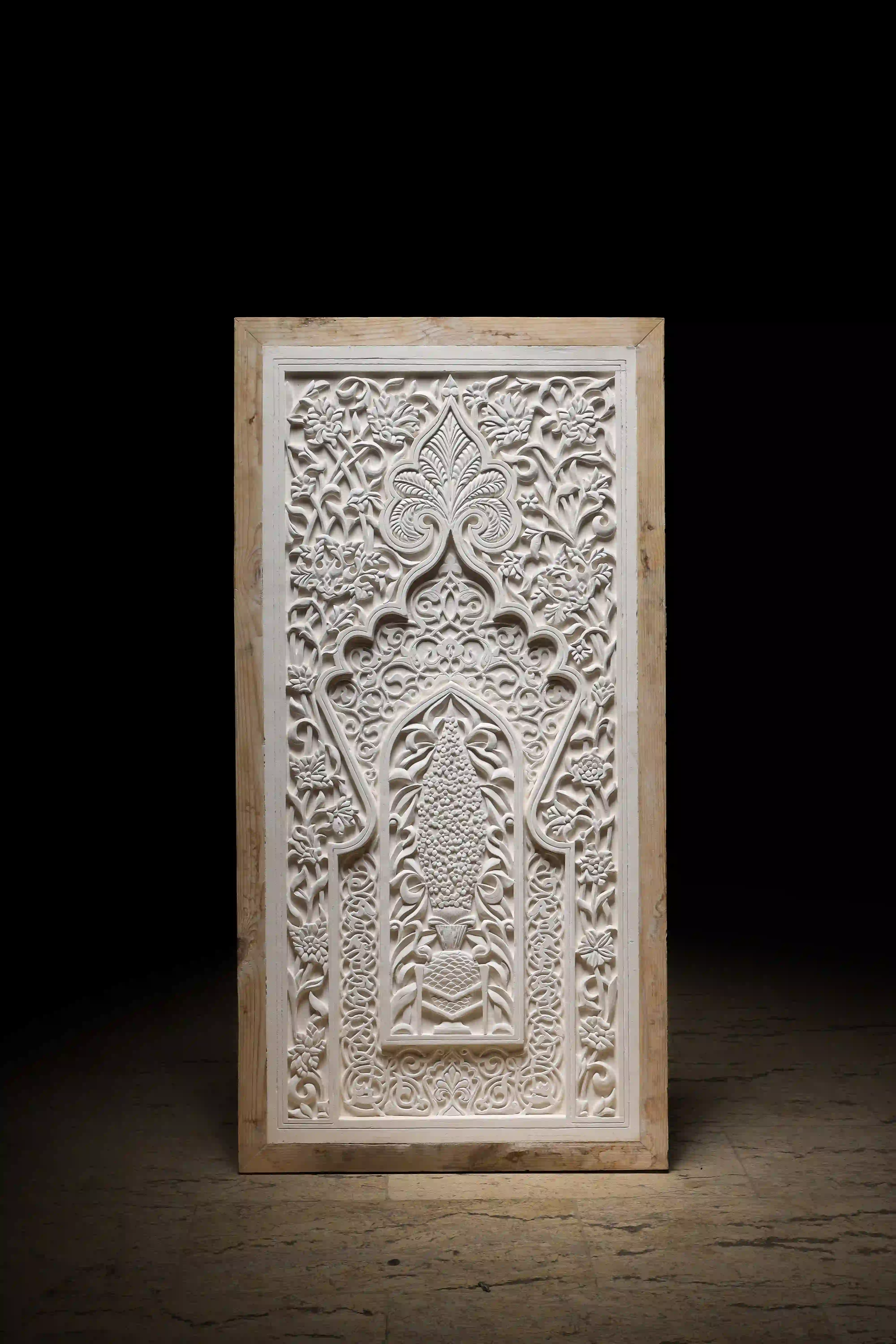
‘Cypress trees’ gypsum panel for prayer room
100 x 50 cm
A cypress tree panel inspired by a unique minbar (pulpit) made in AD 1360 by Hassan Ibn Suleiman al-Isfahani. In the centre, a cypress tree is carved into a prayer niche.
Cypress trees are a symbol of eternal life and death in Islamic arts. One can also see a relief carving of flowers above the niche and Rumi leaves on the interior. The gypsum panel is specially made for a prayer room.
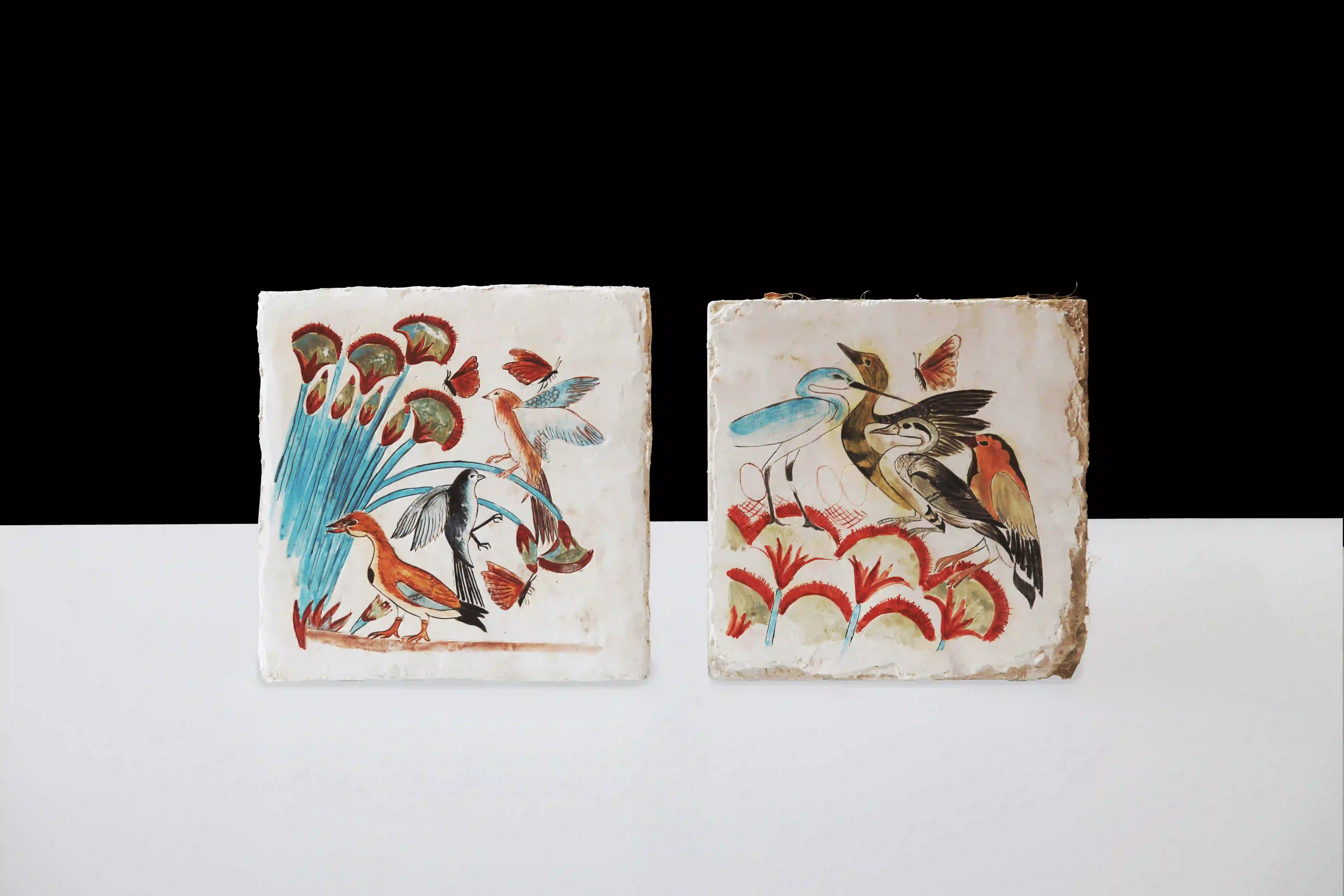
‘Birds from the past’ fresco
30 x 30 cm
‘Birds from the past’ is inspired by the Tomb of Nebamun, circa 1350 BC, at the British Museum.
Tomb paintings served as visual narratives of spiritual beliefs and cultural practices, ensuring the continuity of memory and tradition in the ancient Egyptian quest for immortality.
The fresco technique was employed with fresh lime, natural pigments and water to ensure durability over the years.
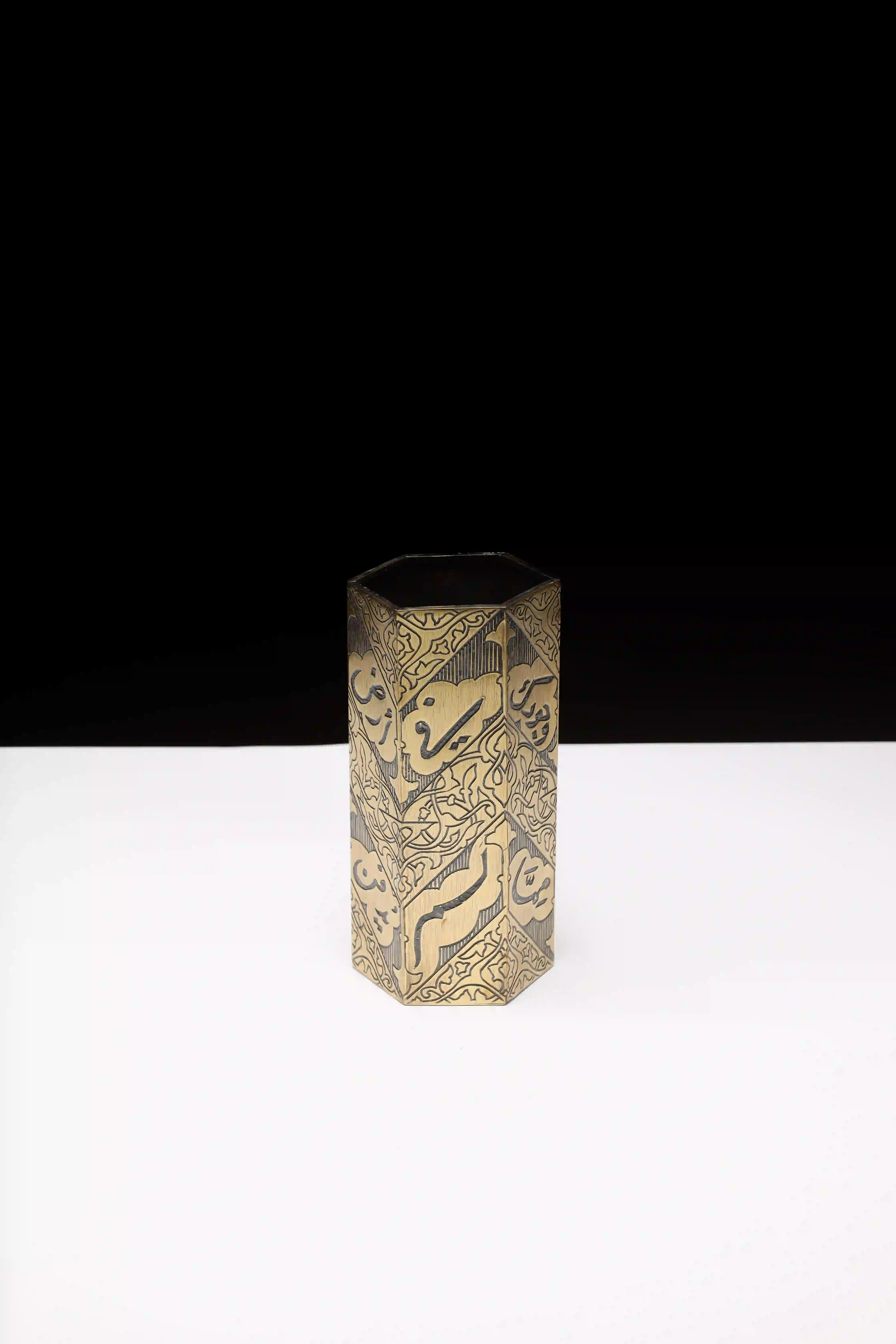
‘Words of wisdom’ vase
8.3 x 17.5 x 8.3 cm
‘Words of wisdom’ is a brass vase inspired by the elegance of 16th century Iranian crafts. Engraved with the wise words of the sage Ibn Ata Allah al-Iskandari, it says:
“Bury your existence in the earth of obscurity, for whatever sprouts forth, without having first been buried, flowers imperfectly.”
The flowers that bloom in this vase represent the beauty that comes from humble beginnings. The intricate engravings invite you to reflect, blending the solid feel of brass with the timeless beauty of this message. This vase is not just a vessel; it shows the wisdom that true merit comes from humility.
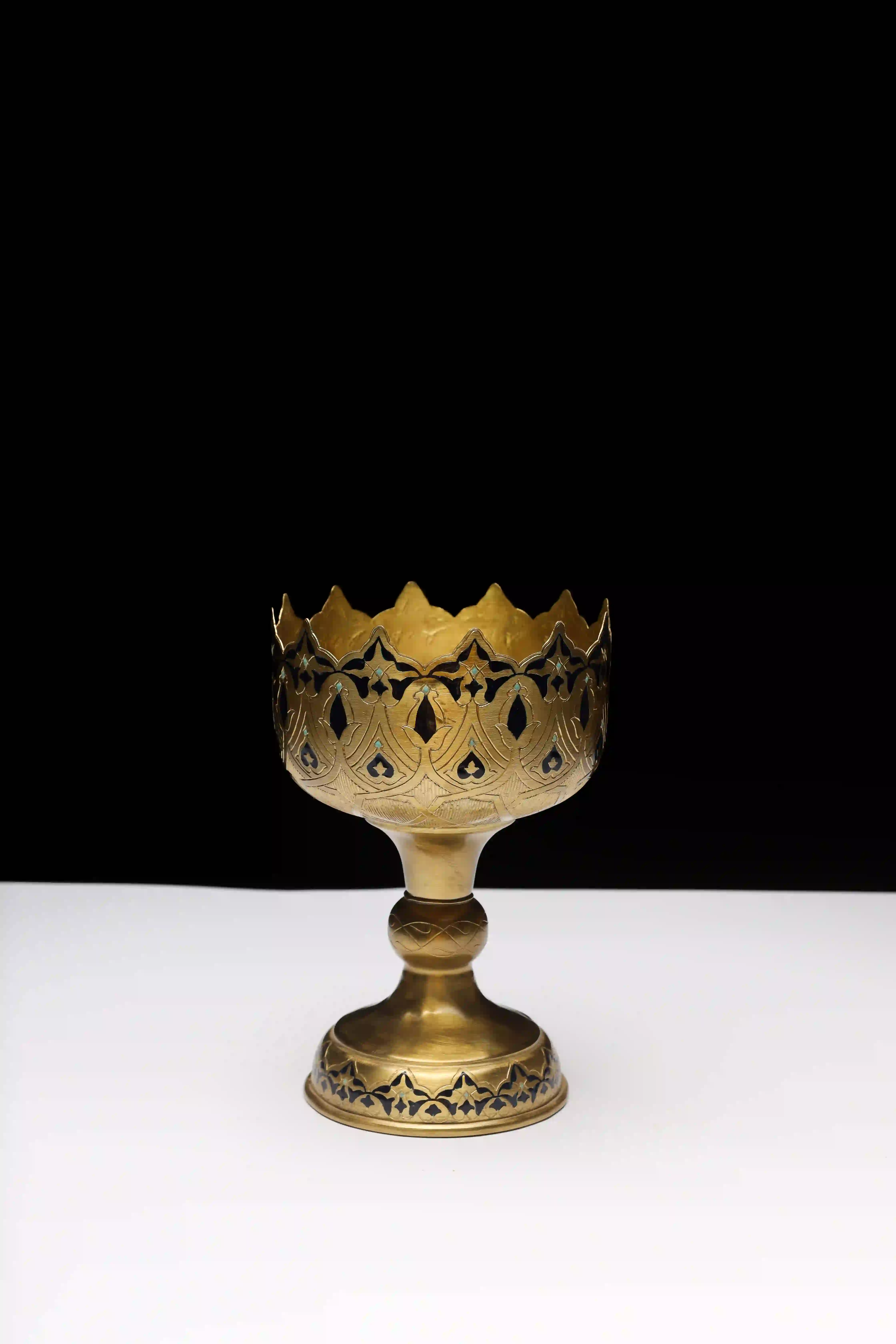
‘Elegance’ potpourri bowl
15 x 21 x 15 cm
‘Elegance’ is a medium-sized bowl that combines beauty and function. Inspired by Persian serving dishes, it features royal dark blue and turquoise hues. Perfect for holding scented potpourri or treats, this bowl is a visual delight, invoking the grandeur of an era when art and utility were one.
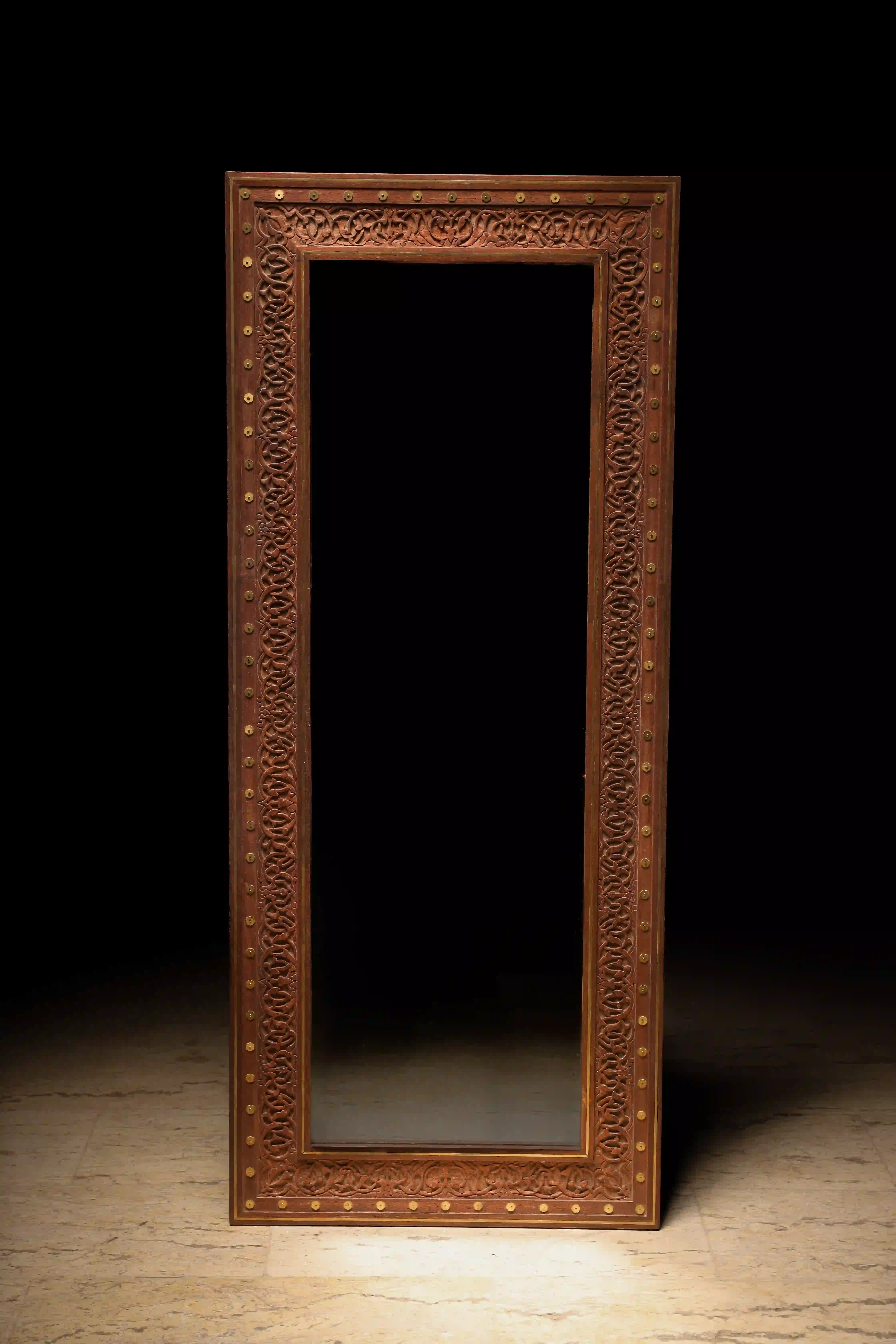
Carved wooden wall mirror frame with embossed brass details
120 x 50 cm
A decorative mirror made of wood and embossed brass inspired by the entrance door of the Mosque of Sultan Barquq and the Complex of Sultan al-Mansur Qalawun in Historic Cairo.
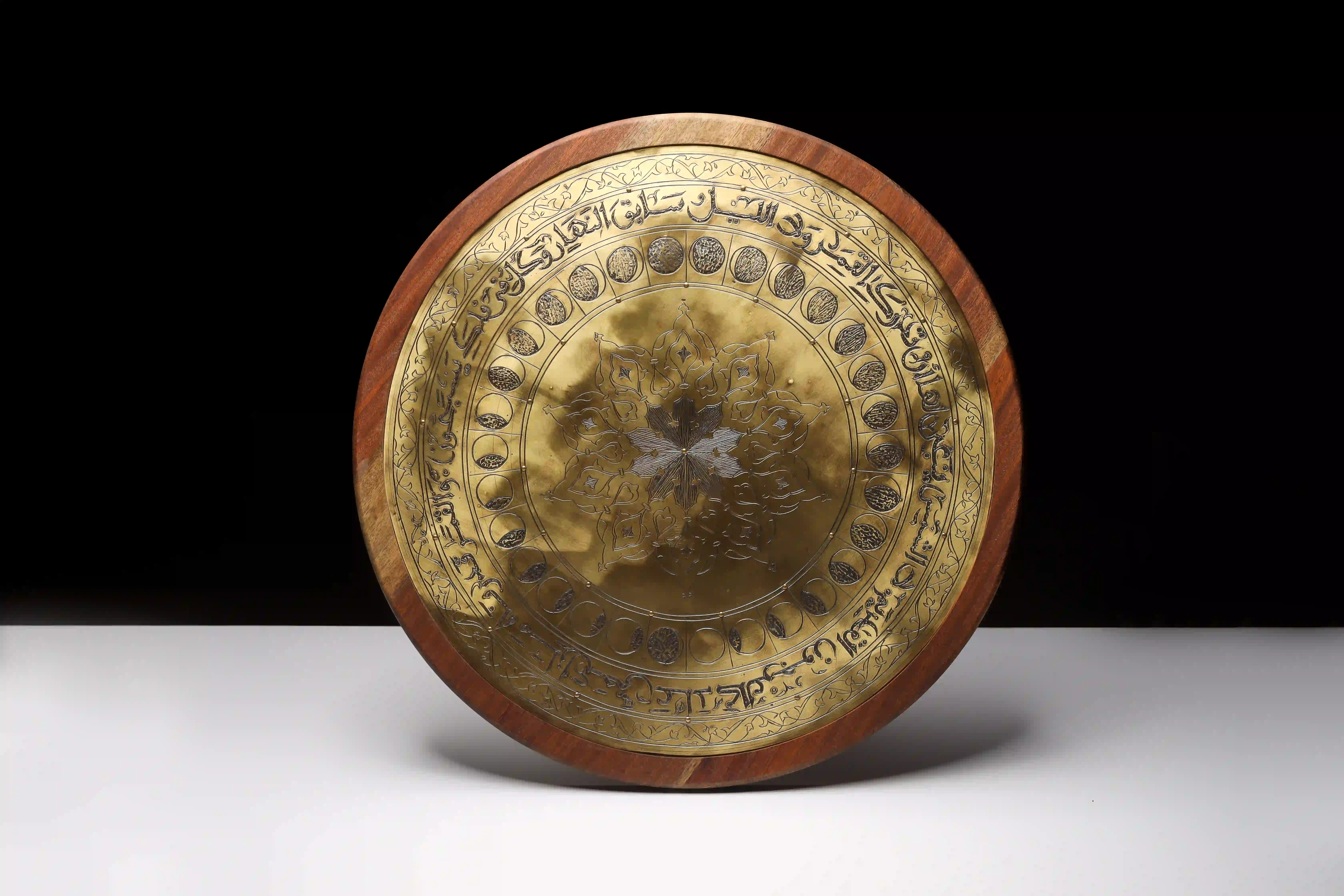
Lunar phases brass wall art
55 cm
Inspired by Sayyid Al-Laali’s exquisite lunar calendar, gifted to Sultan Selim II from Shiraz, Iran, in 1566, this brass wall panel captures the timeless beauty of lunar Islamic calendars. Meticulously crafted using various traditional brass techniques, such as engraving and cavity making, this work features Moorish scripts for a Qur’an verse describing the different phases of the moon.
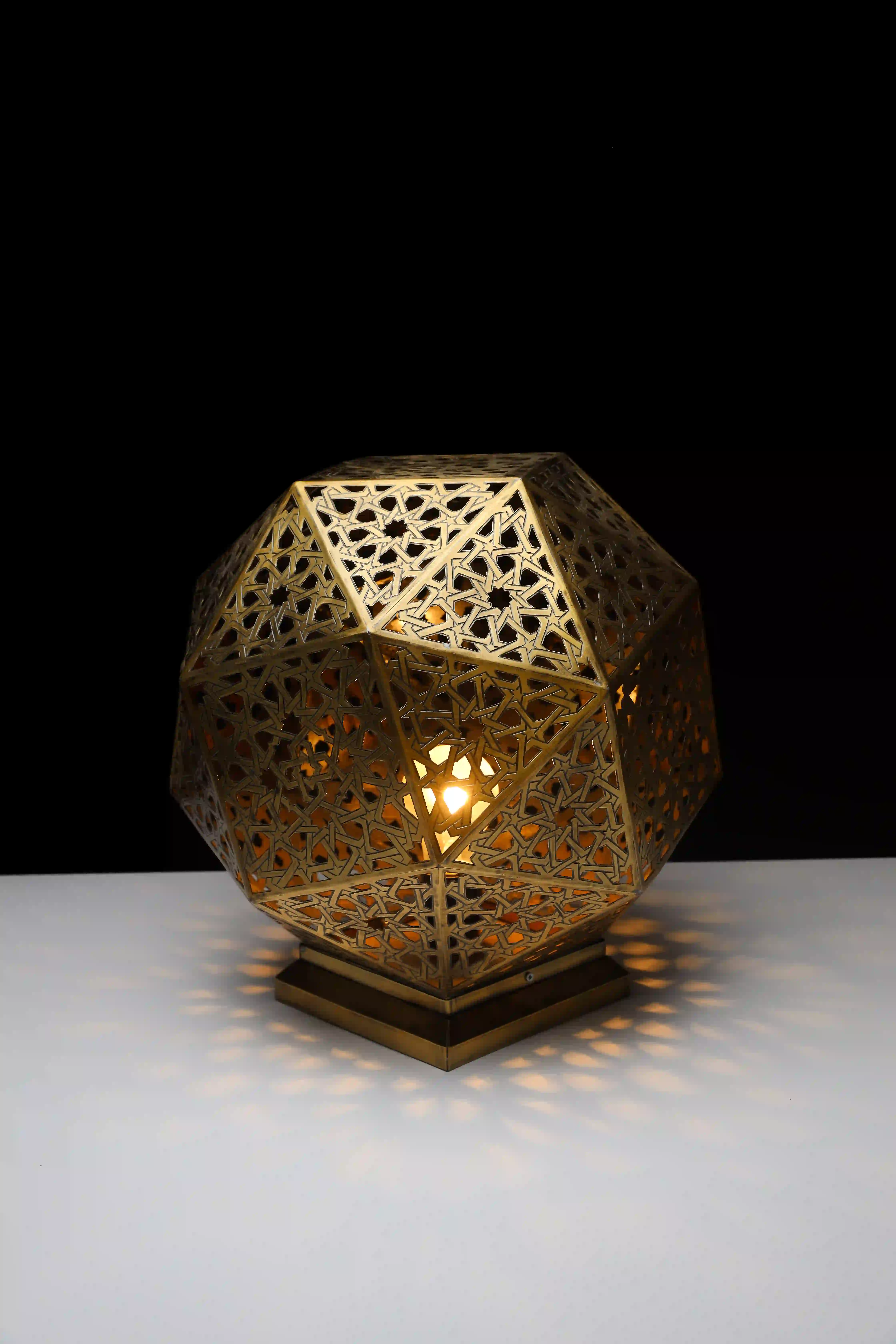
Brass polyhedron lighting unit with a Moroccan-Andalusian pattern
104 x 13 x 14 cm
This visually striking brass piece is inspired by a snub cube, the geometric structure with 38 faces: six squares and 32 triangles. This polyhedron serves as the foundation for a unique lighting unit that blends modern design with traditional Moroccan-Andalusian patterns. The snub cube belongs to a family of Archimedean solids, known for their symmetrical beauty and mathematical precision. This arrangement showcases mathematical elegance. The use of geometric shapes and rosette patterns reflects a deeper exploration of symmetry and form, typical of both classical geometry and Islamic art traditions. The interplay of light and shadow on the polyhedral surfaces further accentuates its geometric intricacies, creating a captivating visual experience.
We believe that our students are fortunate to live in Cairo, a city with numerous monuments and museums. These glorious buildings serve as a profound source of inspiration. Every year, we select one of Cairo’s renowned monuments and ask our students to create artistic replicas of selected artworks that correspond to the crafts that they have been studying. The importance of the heritage project lies in its role as a transitional phase between classwork and the graduation project. The heritage project provides students with the opportunity to understand the mechanics of manufacturing processes, which include teamwork, time management and the crucial phases of experimentation and testing. Engaging in such a project makes students more confident in thinking about and designing their own pieces for their graduation projects.
Over the years, we have examined and worked on an extensive list of monuments, which includes Al-Maridani Mosque, Sultan Barquq Mosque, Tikkyat Al-Gulshani, Bayt Zeinab Khatoun, the Museum of Islamic Art and the Coptic Museum. This year, the Gayer-Anderson Museum was also selected as a source of inspiration for our students.
The Gayer-Anderson Museum, also known as Bayt Al-Krietiliya, is a 17th-century house in Cairo’s Sayyida Zeinab neighbourhood that epitomises the richness and complexity of Cairene traditional architecture. Moreover, it houses a vast collection of antiques from different parts of the Islamic world, collected by Robert Grenville Gayer-Anderson, a British Army major and former Oriental Secretary to the High Commissioner in Cairo, who resided in Egypt between 1912-1942.
The museum contains numerous art pieces that provide inspiration to our students. Although the selection process was not easy, we succeeded in finding art pieces that were both aesthetically appealing and relevant to the skills of the students. From the museum’s large collection of ceramic tile panels, two panels were selected that represented contrasting artistic themes. For the traditional joinery students, a cupboard leaf with intricate geometric patterns was chosen, while a beautiful box with inlay work was selected for the decorative techniques group. For the metalwork students, we selected a large brass tray covered with floral patterns and Qur’anic inscriptions, along with a chandelier. Lastly, for the gypsum carving group, a beautiful window grille was taken as inspiration, for its floral motifs that were popular in Cairo during the Ottoman period.
Mamdouh Sakr
Programme Manager
The Jameel House of Traditional Arts in Cairo
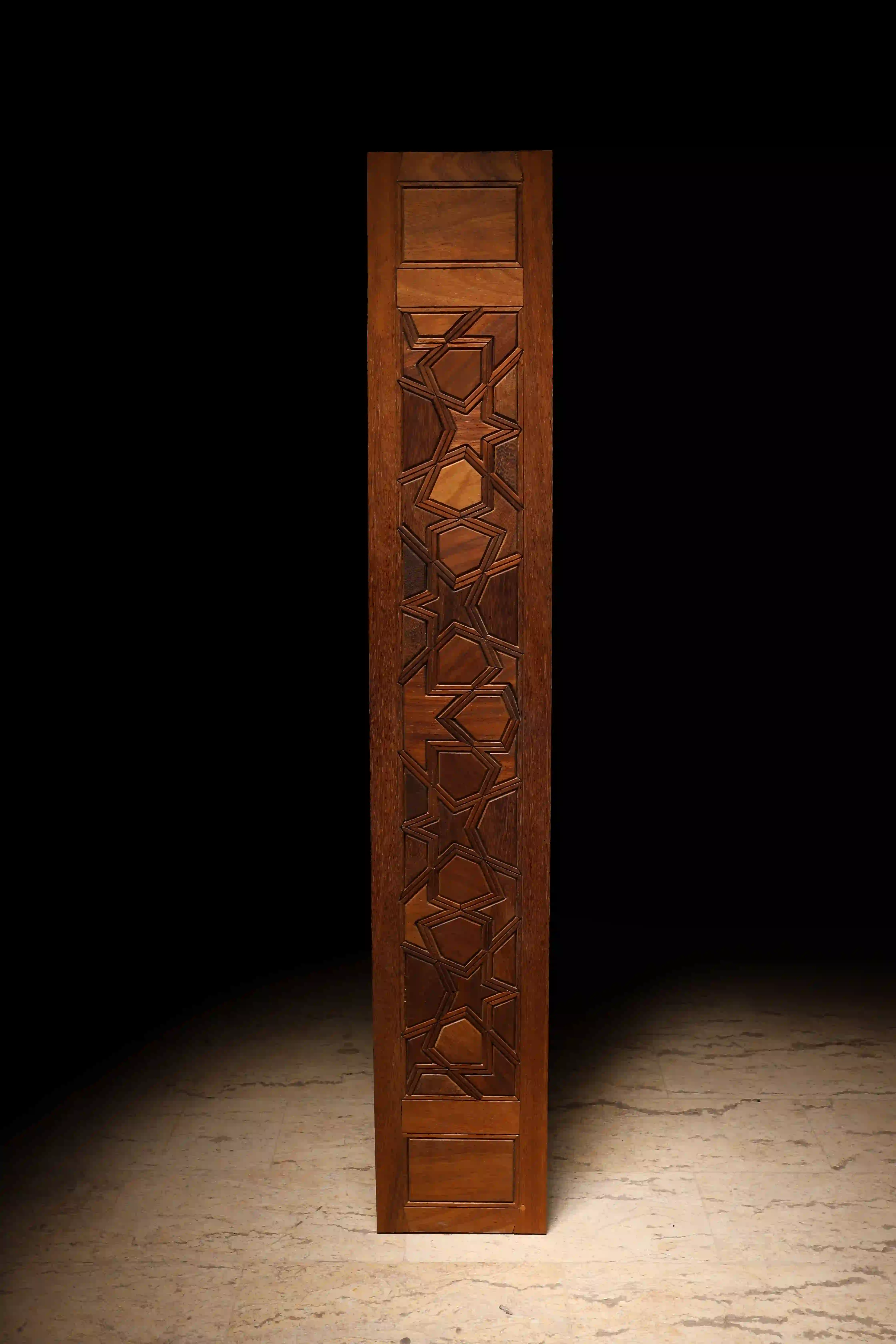
Wooden cabinet panel
170 x 30 cm, 100 pieces
A replica panel of a wooden door of a cabinet in Cairo’s Gayer-Anderson Museum, dating back to the Ottoman era. Crafted using traditional joinery techniques, it features a network of eight-fold rosettes with interstitial spaces that showcase the unique complexity of the design. The panel is carved and assembled without the use of glue or nails, highlighting the precise craftsmanship of the period.
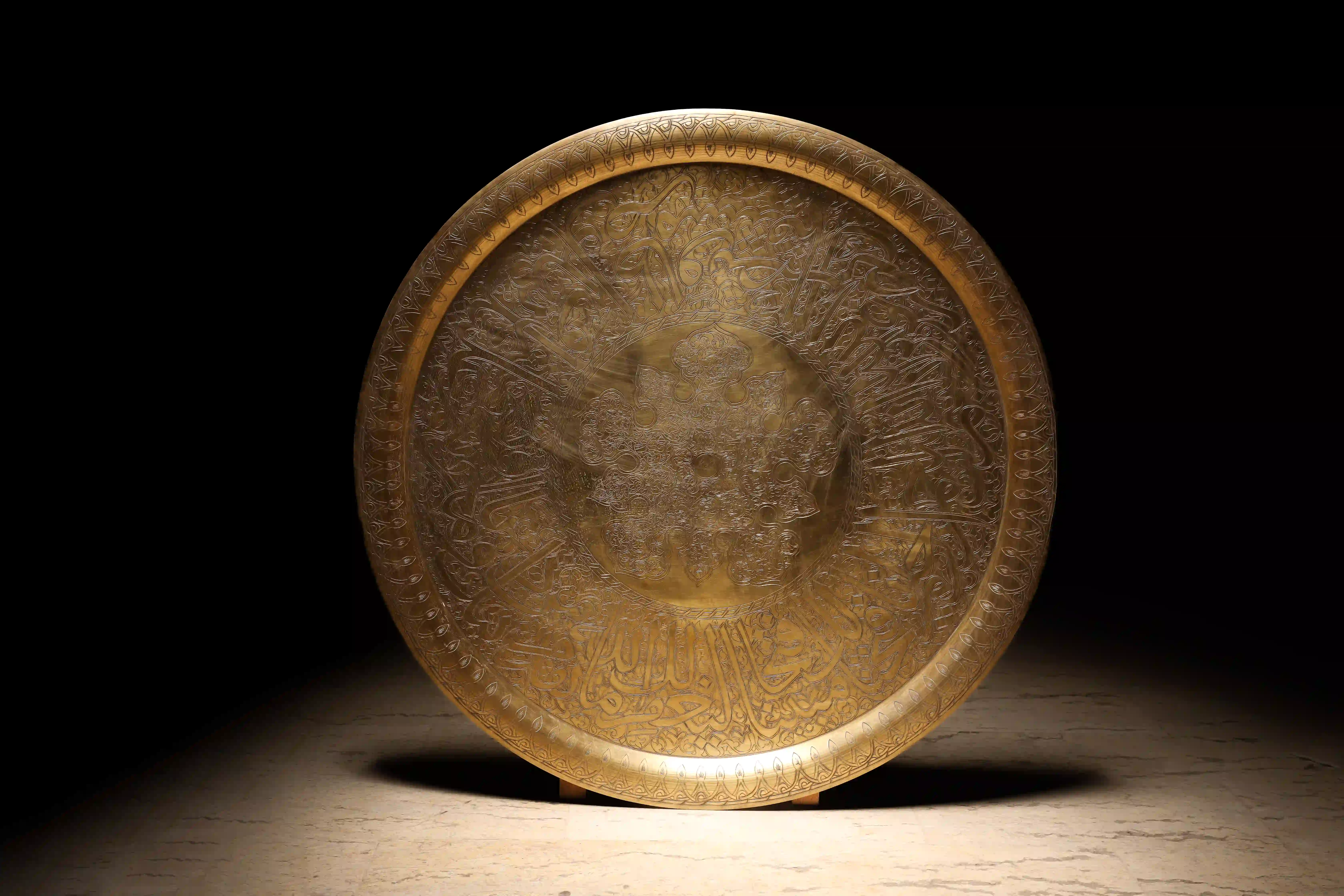
Engraved brass tray
100 cm
A replica of a brass tray from the Gayer-Anderson Museum, Cairo, this piece features a Qur’anic verse written in MamlukThuluth script with intricate floral patterns, created using the traditional techniques of brass engraving, turning and oxidisation.
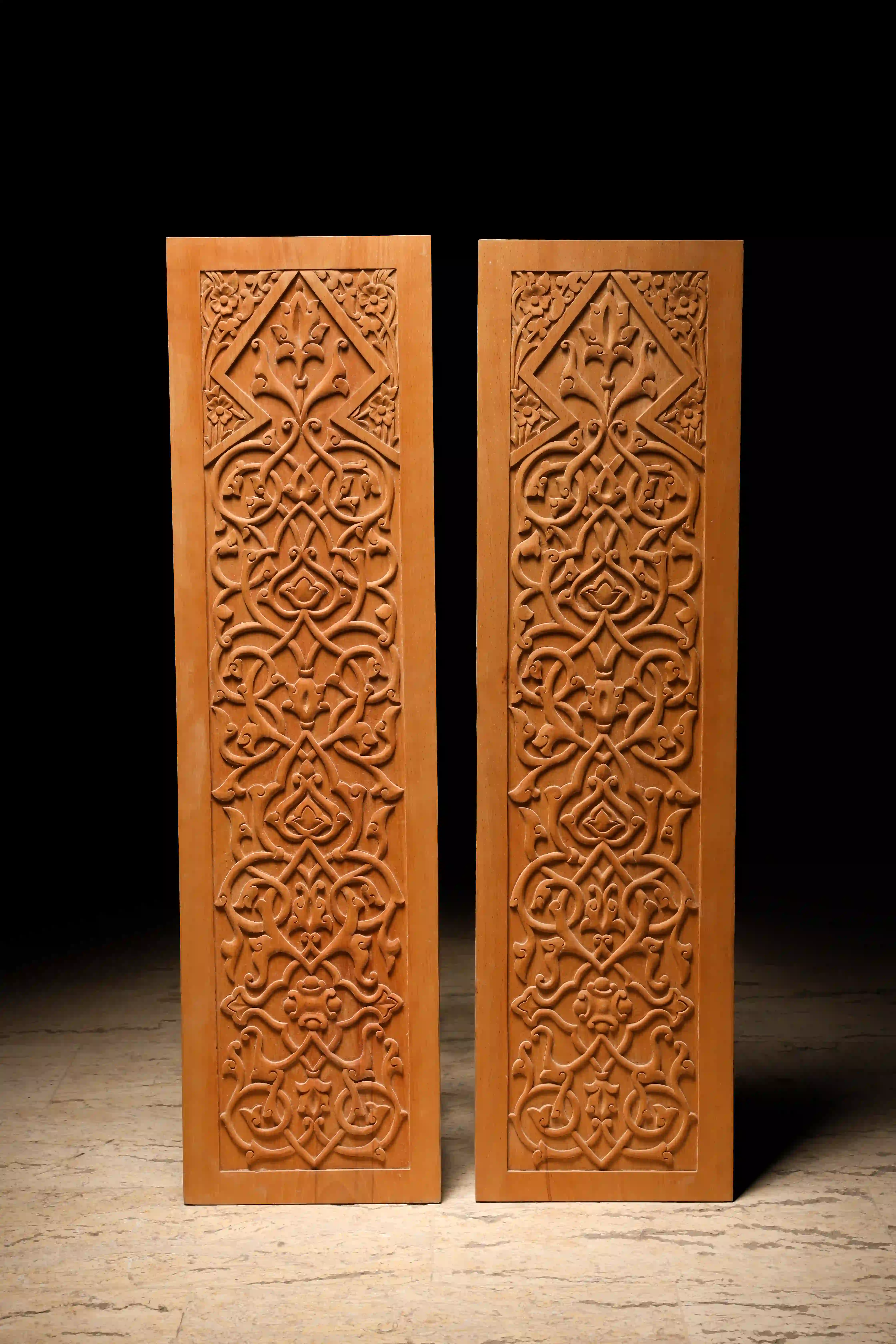
Carved wooden panels
104 x 13 x 14 cm
Two wooden panels, intricately carved with floral designs, are replicas of the doors of a wooden cabinet from Cairo’s Gayer-Anderson Museum, crafted using traditional woodcarving techniques.
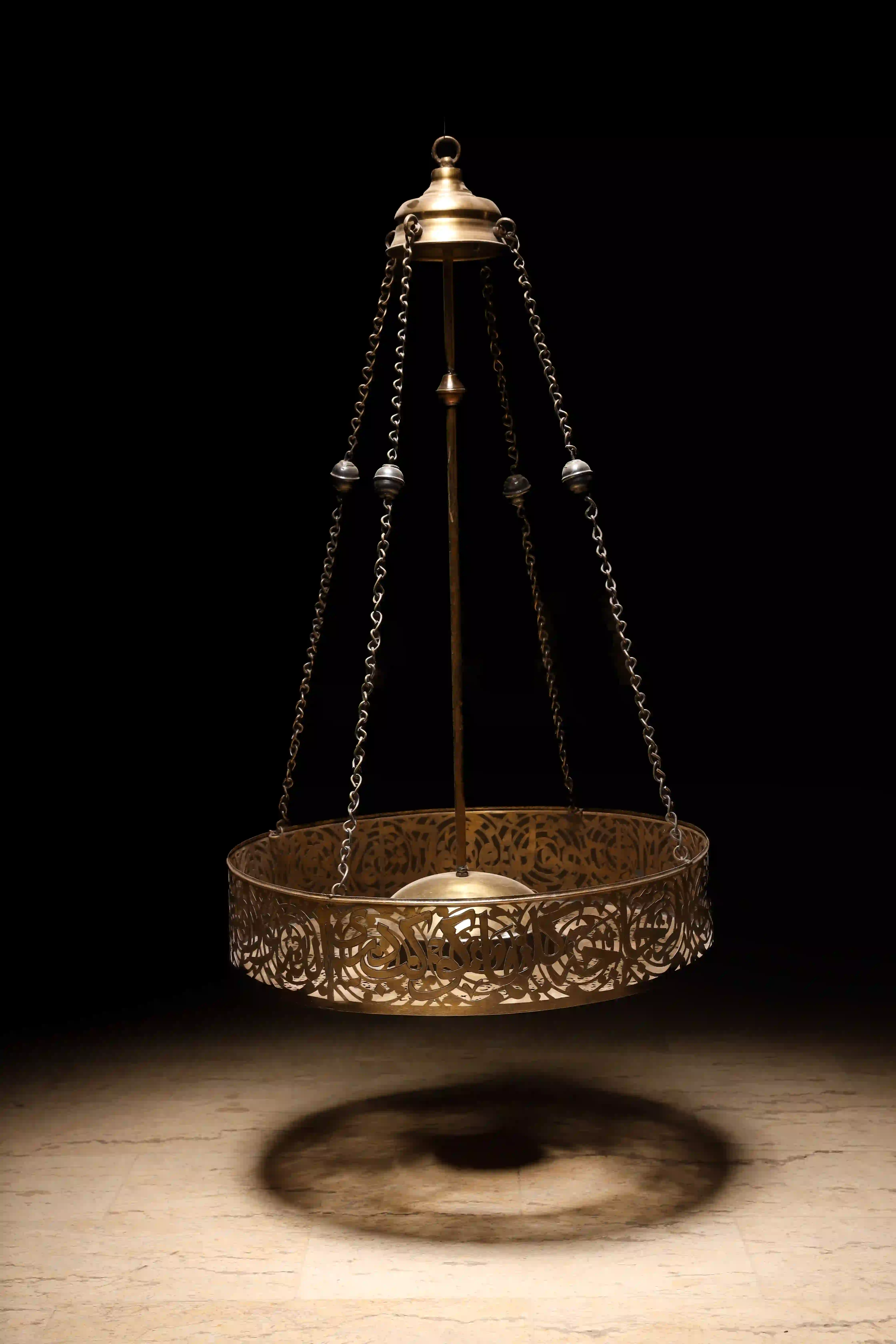
Brass chandelier
60 cm
A replica of a piece found in the Gayer-Anderson Museum, Cairo, this brass chandelier is expertly crafted using traditional techniques. The creation process includes brass sawing, intricate engraving, welding and oxidisation.
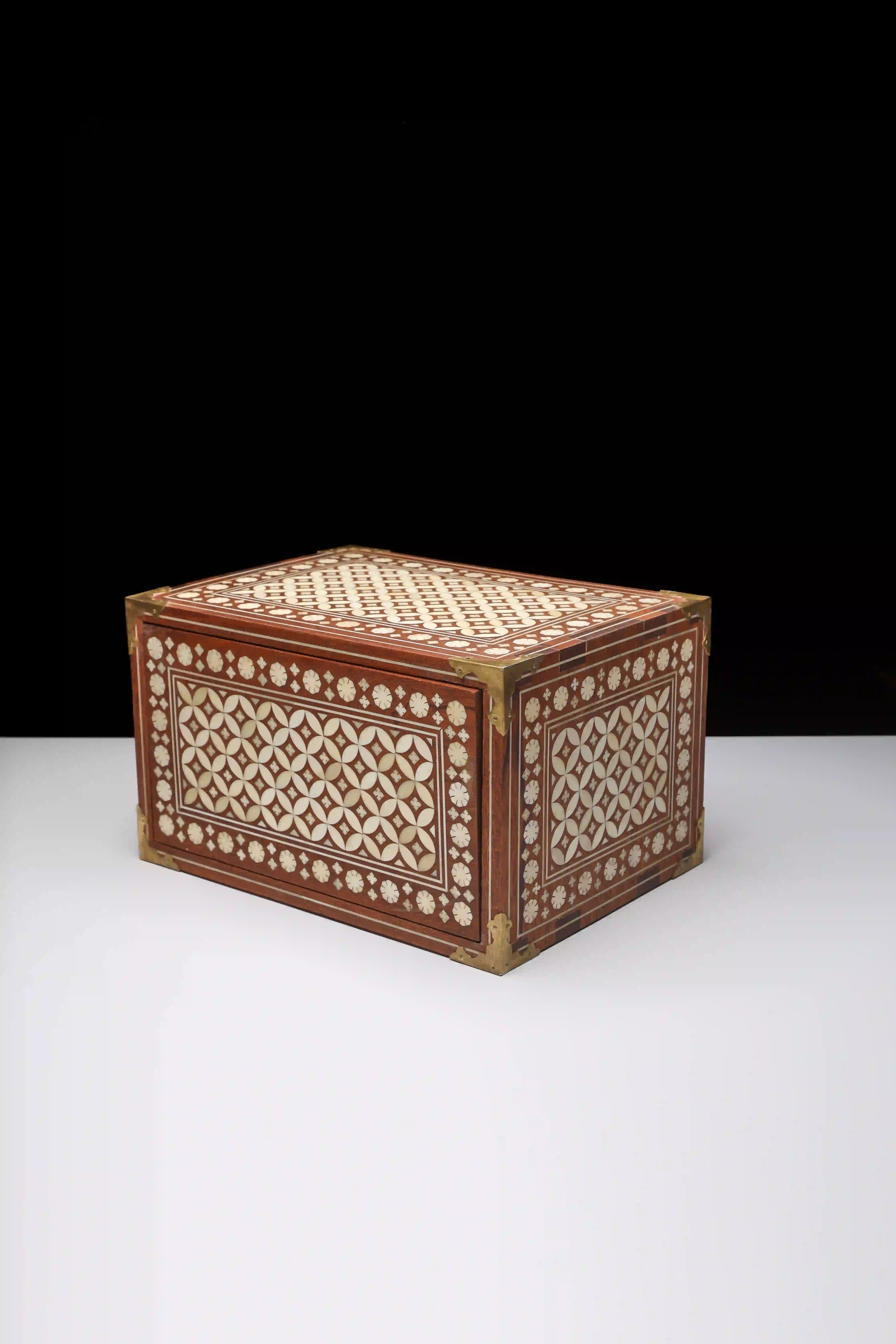
Inlaid wooden box
25 x 34.5 x 20 cm
A replica of an antique wooden box from the Gayer-Anderson Museum, inlaid with camel bone.
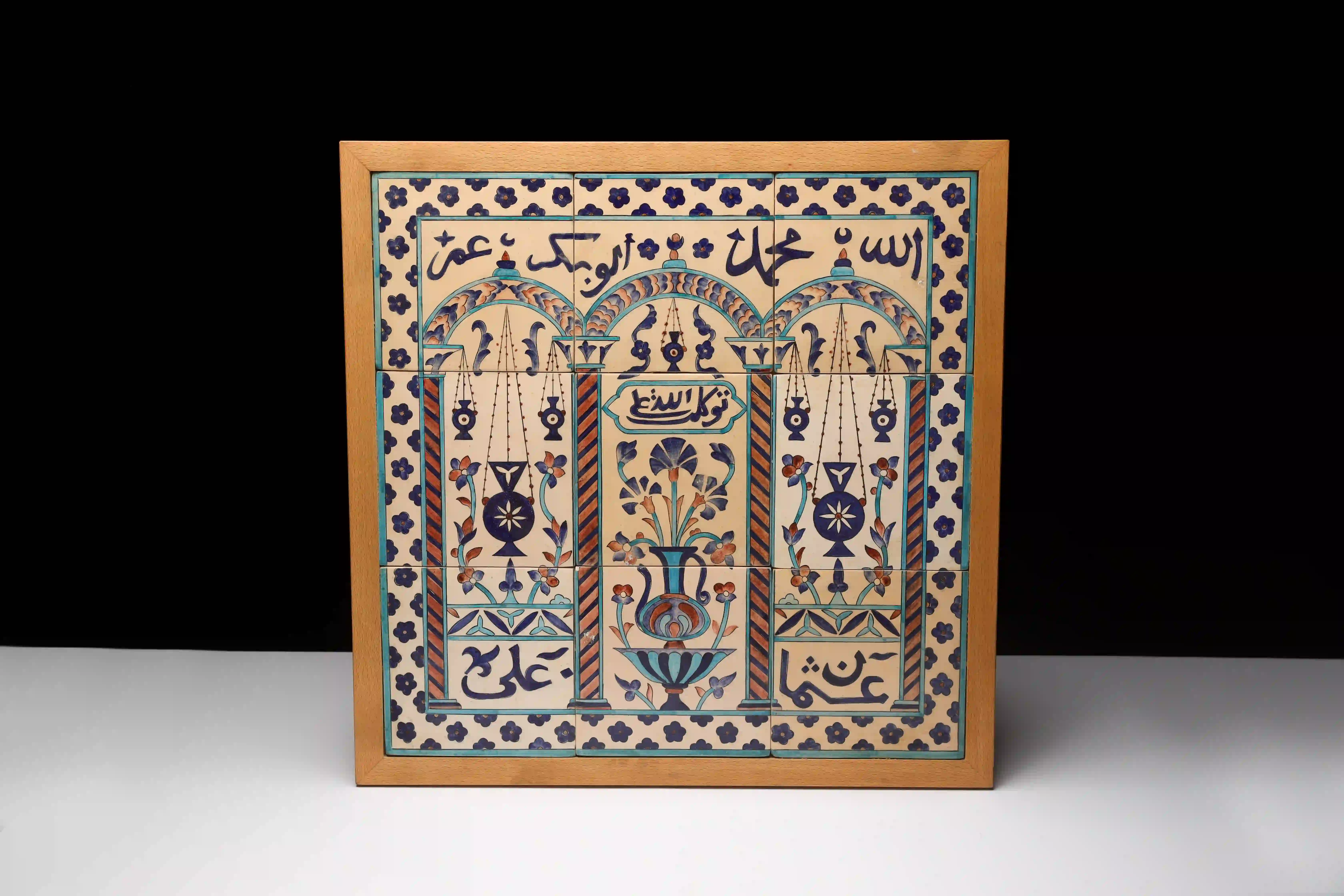
Esraa Badawy and Bassant Darwish
45 x 45 cm
A replica panel of Damascus tiles in the Gayer-Anderson Museum, Cairo, dating back to the 17th century. It features the names of Allah, the Prophet Mohammad and the Rightly-Guided Caliphs, amidst distinctive floral decorations executed using the underglaze painting technique.